It seems we can’t find what you’re looking for. Perhaps searching can help.
Sign Up for newsletter!
Subscribe to get the latest eBook!
Hotline



 2
2
 2,677
2,677
 0
0
 1
1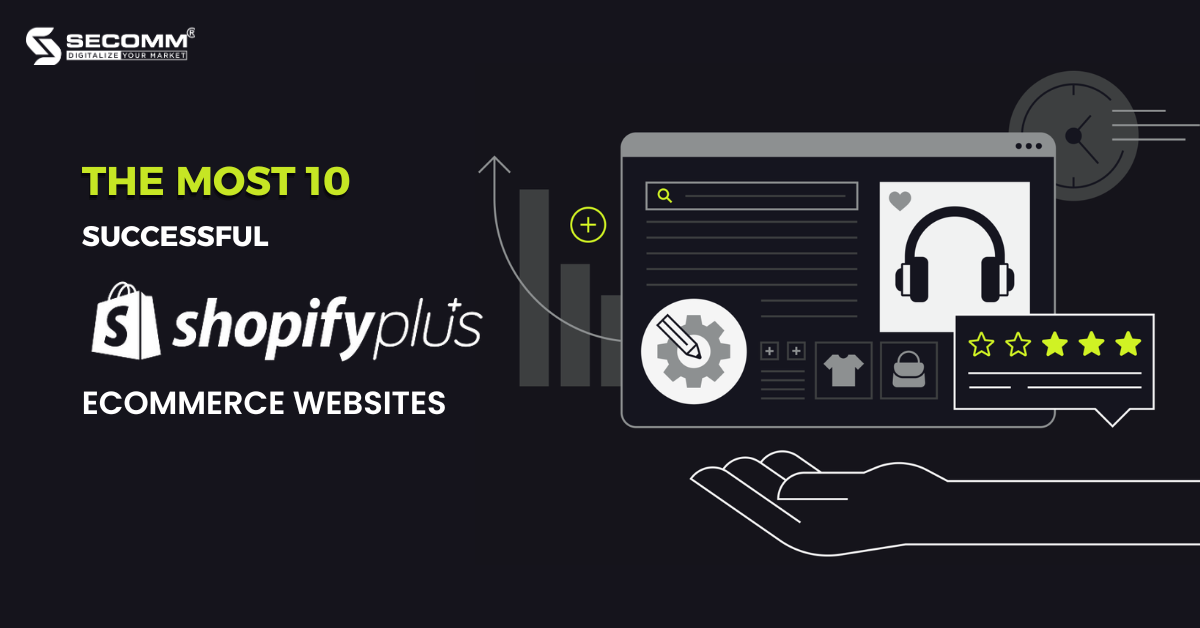
 2
2
 9,374
9,374
 0
0
 1
1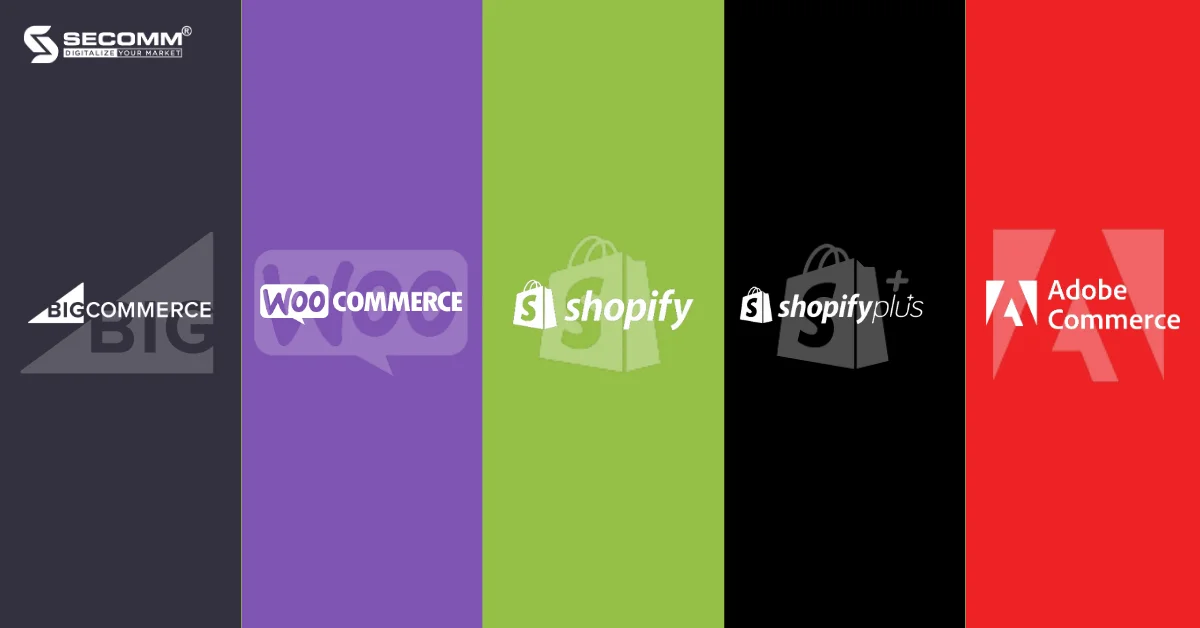
 2
2
 9,331
9,331
 0
0
 1
1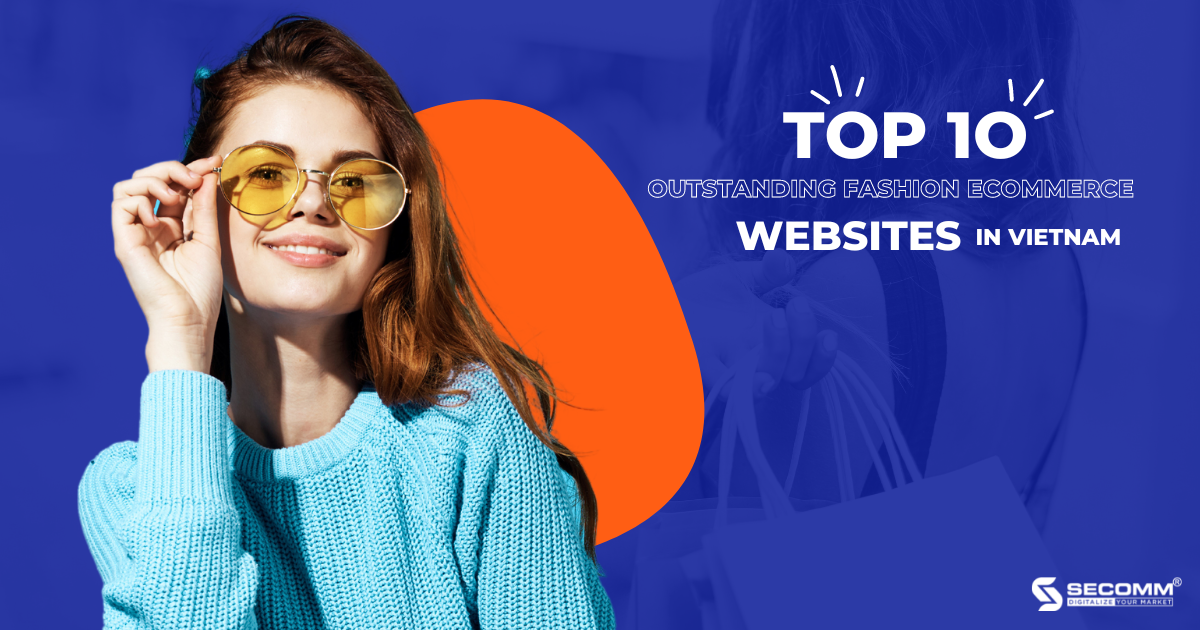
 2
2
 9,305
9,305
 0
0
 1
1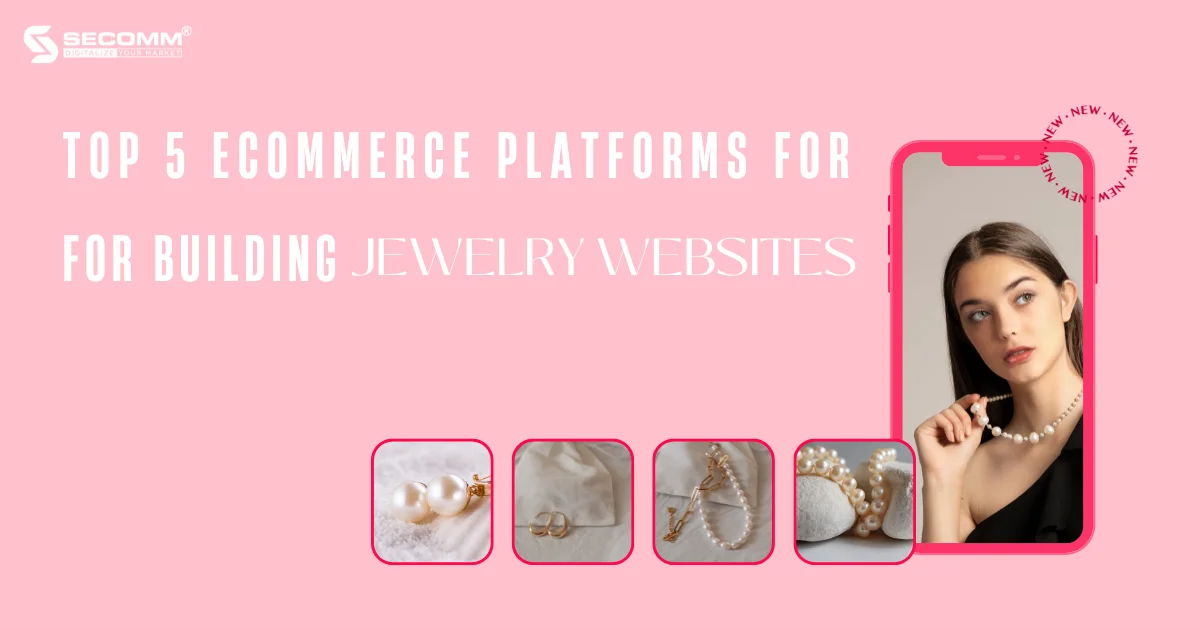
 2
2
 9,230
9,230
 0
0
 1
1




Faced with various market influences, the demand for developing eCommerce systems among businesses in Vietnam is gradually becoming more defined and undergoing a stronger transformation. The Covid-19 crisis, in particular, has been a significant catalyst accelerating this transformation process rapidly.
So, how should businesses chart their journey in developing an eCommerce system to not only adapt to market and customer changes but also seize opportunities and excel in this highly competitive arena?
In general, the development journey of eCommerce systems for Vietnamese businesses, from the initiation of business to expanding the scale with a specialized eCommerce system, typically goes through three important milestones.
Businesses need to thoroughly understand these milestones and coordinate with a detailed examination of goals, budgets, and the current state of the business to devise an appropriate and tailored development journey.
The emergence of the eCommerce marketplace has efficiently addressed the online buying and selling needs not only for small online shops, startup businesses, and small to medium-sized enterprises but also for large brands.
With an extensive operational system, eCommerce marketplaces create many favourable opportunities for businesses and individual small-scale entrepreneurs with budget constraints. By only incurring basic expenses for setting up a storefront and annual maintenance fees, businesses and store owners can quickly have their shops.
Additionally, processes such as payment, shipping, customer care, post-delivery issue resolution, and marketing programs are simplified with comprehensive support from eCommerce marketplaces. Choosing an eCommerce marketplace to initiate business is a suitable start, helping businesses increase brand coverage, competitive ability, and sales volume at cost savings.
Even large brands/brands that have developed offline are currently utilizing eCommerce marketplaces to penetrate and expand the market. For developed brands and traditional businesses looking to transition to online business, eCommerce marketplaces are the right starting point to test eCommerce business.
From there, businesses can build a comprehensive eCommerce development strategy, from eCommerce marketplace to social commerce, brand.com website development, and implementing an omnichannel approach.

In Vietnam, popular eCommerce marketplaces such as Shopee, Lazada, Tiki, Sendo, etc., are favoured by many businesses. With a massive monthly user base and attractive promotion programs, diverse service systems, eCommerce marketplaces maximize support for sellers in swiftly bringing their brands and products to the market through simple steps:
Despite the significant benefits of doing business on eCommerce marketplaces, businesses and individuals are subject to substantial dependence on policy and operational changes. They also face limitations in accessing and leveraging potential customer data to improve marketing efficiency or personalize the customer experience. Furthermore, businesses must directly compete with a large number of similar stores and brands on the platform regarding pricing and product quality.
In addition to doing business on eCommerce marketplaces, businesses can independently develop a basic eCommerce system, getting closer to potential customers and implementing their own eCommerce Marketing programs.
Developing a basic eCommerce system does not require excessive investment in time, development costs, or website programming. Businesses only need to use free website-building tools with available interfaces and features to easily create a website through simple drag-and-drop operations.
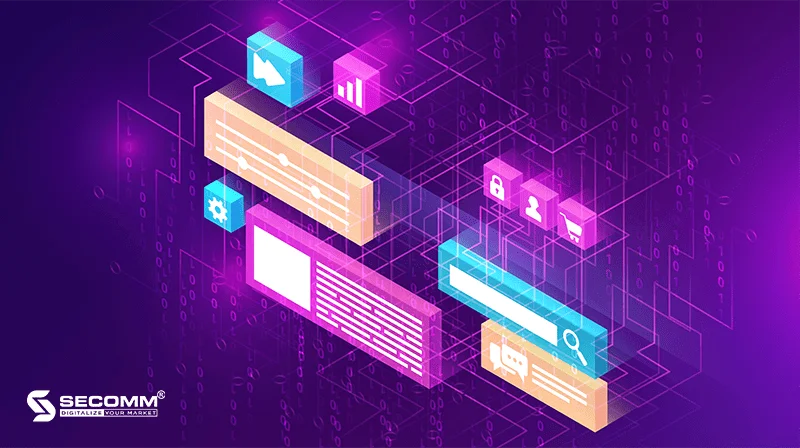
Some popular website building tools in the current Vietnamese market that support the development of a simple eCommerce system include Sapo, Haravan, and Nhanh.vn.
Based on criteria such as simplicity, availability, time and cost savings, most of these tools will meet the basic needs of developing an eCommerce system. However, available website design tools also pose several challenges, limiting business operations and eCommerce expansion:
Typically, after a period of doing business on eCommerce platforms or using available website design tools, businesses gradually recognize the need to develop a specialized eCommerce system designed to propel a sustainable eCommerce journey.
Developing a specialized eCommerce system requires both experience and substantial investment in terms of costs and deployment time. However, this approach proves to be a cost-effective solution for the long-term business plans of companies, delivering sustainable business efficiency, and serving as a perfect transition for an independent and comprehensive eCommerce system.

Developing a specialized eCommerce system will maximize meeting various needs, such as:
Among the specialized eCommerce platforms widely used by businesses today, such as Shopify, BigCommerce, and WooCommerce, Magento stands out with significant advantages and caters to all business needs from simple to complex. Many multinational corporations currently leverage Magento to build sophisticated eCommerce systems, including names like Samsung, Nike, Coca-Cola, Lenovo, Olympus, Port, Pox, Nestle, BevMo, Burger King, and Murad, among others. Additionally, millions of small and medium-sized eCommerce sites worldwide are also built on this platform.
With all the outstanding advantages of a specialized eCommerce platform, Magento is undoubtedly a suitable choice for both B2B and B2C businesses, catering to businesses of all sizes, from startups to large enterprises.
Contact SECOMM for a detailed consultation on the comprehensive and sustainable development journey of your eCommerce system for businesses.
Also, explore Magento solutions tailored specifically for SMEs in Vietnam!
 2
2
 6,865
6,865
 0
0
 1
1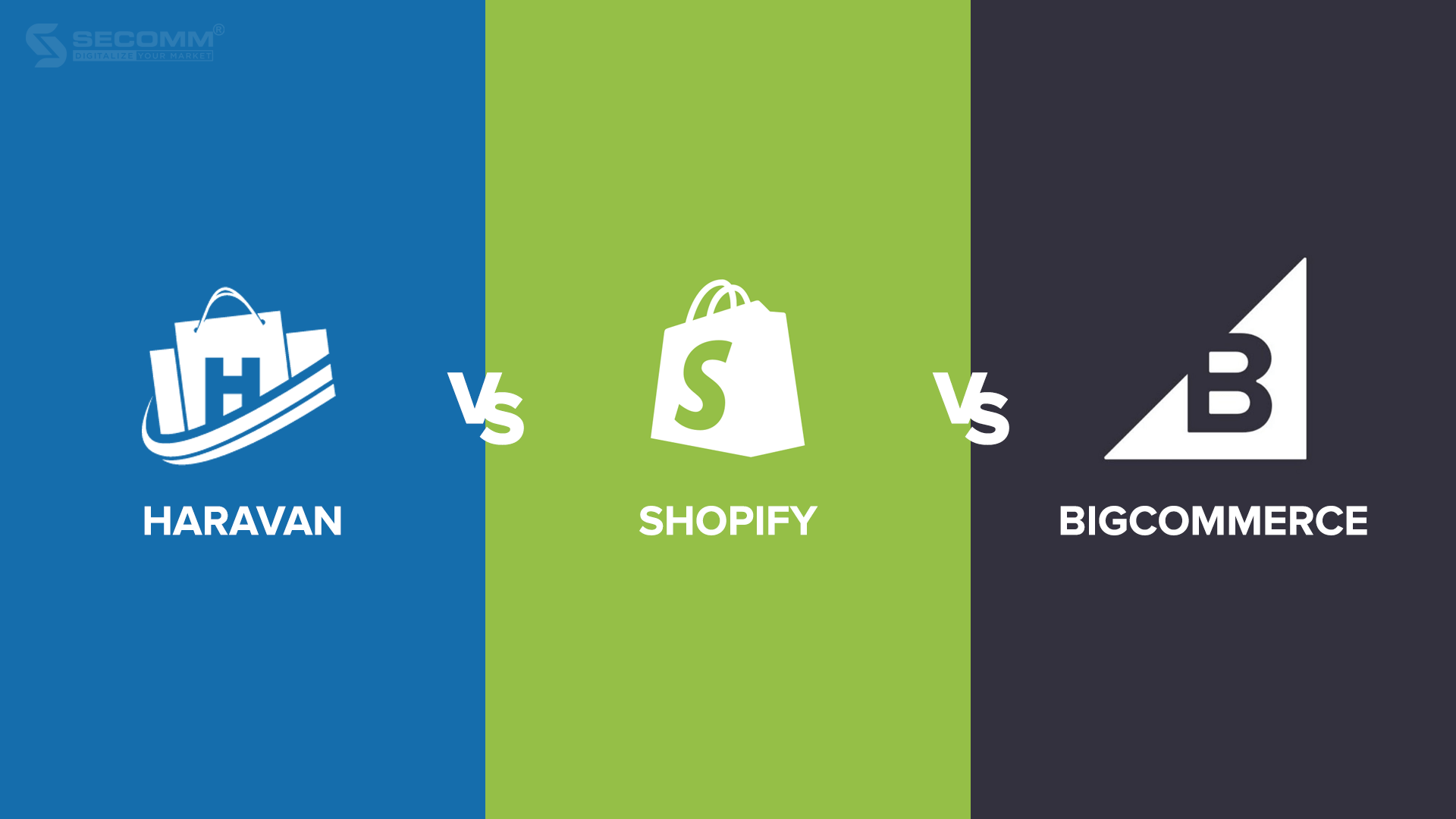
Many firms have selected SaaS eCommerce platforms to create e-commerce enterprises for brands because of their essential qualities, which can rapidly install eCommerce at a low cost.
In Vietnam, Haravan is the most popular eCommerce platform that allows multi-channel sales. This platform was officially launched in 2014, aims to assist companies in developing professional e-commerce websites at an affordable cost.
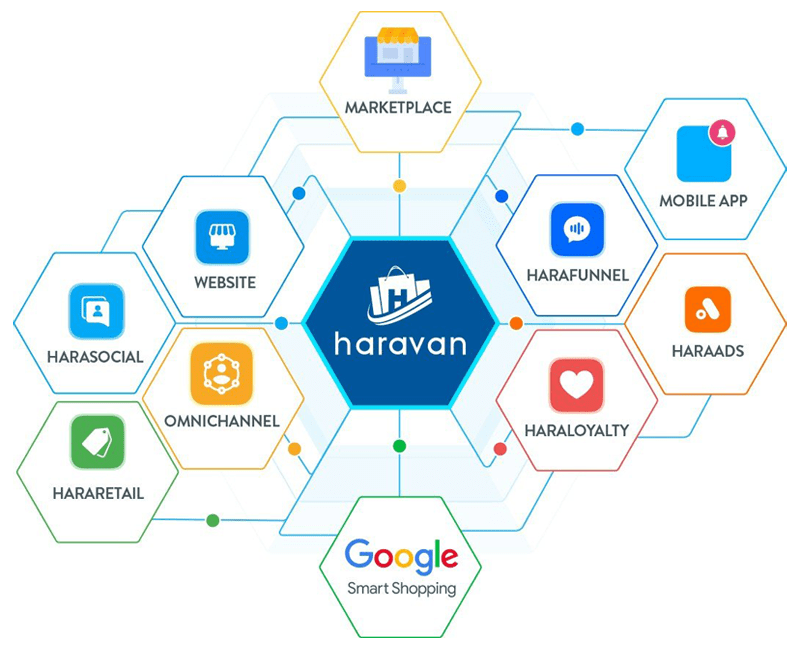
Haravan provides many UI/UX themes so that firms may select a design that suits the brand’s image. At the same time, many organizations regard the admin interface to be easy to use. However, companies must pay additional fees to raise the number of admin accounts.
Haravan’s essential features, on the other hand, are just enough for businesses to run their web operations successfully but not ideal sufficient for long-term development. In addition, because Haravan is a SaaS platform, organizations find it difficult to customize or expand functionality outside of its ecosystem.
Haravan’s drag-and-drop manipulation allows companies to create an eCommerce website with all the critical functionality for business online in around 30 minutes.
Businesses must pay a monthly charge ranging from 200,000 VND to 3,000,000 VND based on their demands:
Haravan is now gaining popularity in the Vietnamese eCommerce business, particularly in the B2C model or low-involvement product business, due to its ability to deploy with affordable charges swiftly. Vinamilk, Juno, and L’Oréal are some companies that use Haravan.
Shopify is a software-as-a-service platform for online retailers and point-of-sale systems. Shopify is popular among the eCommerce community due to its simplicity, quick development timelines, and low setup expenses.

Shopify provides many attractive themes that are device-agnostic and ideal for a broad array of industries. Shopify’s admin dashboard is simple to use, and it offers a Vietnamese version for Vietnamese firms. Like Haravan, firms must upgrade their service packs to expand the number of admin accounts.
Depending on the system’s complexity, each business will need some time to get used to Shopify. Still, in general, it will not take long for companies to establish a website, taking between 1 and 2 days on average.
Shopify has created a variety of packs for companies to choose from:
Shopify also creates different service bundles to meet a range of organizations:
Shopify is constantly developing and enhancing its offerings to meet a wide range of customer requests rapidly and effectively, making it perfect for B2C enterprises. However, the monthly cost is a significant impediment because firms must pay significantly more to use extra functions. Sony Vietnam, Vsmart, and DHC Vietnam are some Vietnamese companies that use Shopify.
BigCommerce is a SaaS platform that launched in 2009 and has made a significant impact on the eCommerce developer community. Despite being founded later than other platforms, BigCommerce does not fall behind in terms of a functional system, theme store, and so all.
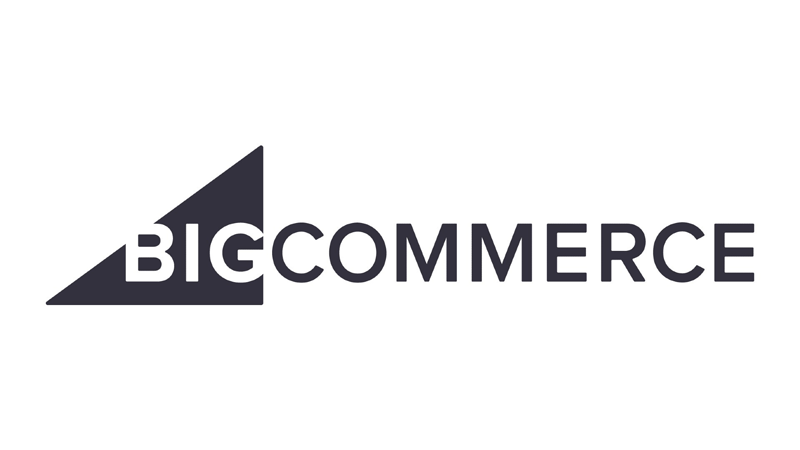
BigCommerce provides a wide range of visually appealing themes and adapts to customer behavior, including 12 free versions and over 160 professional ones. BigCommerce’s admin dashboard is easy to use, and it supports businesses in rapidly setting up eCommerce websites. However, since BigCommerce does not offer a Vietnamese version, firms must hire and train English-qualified employees to manage the site.
BigCommerce’ packages are jam-packed with features and add-ons to help businesses achieve solid internet business. However, BigCommerce’s capacity to customize and expand functionalities remains limited, restricting firms from adapting to their needs to deal with industry-specific difficulties.
Thanks to its drag-and-drop page builder feature, the time it takes to establish a website on BigCommerce is shortish. BigCommerce construction process takes about 1-2 days on average.
BigCommerce now supports three package options and one on-demand solution:
Moreover, BigCommerce will charge you additional fees based on your online sales.
Overall, BigCommerce is not inferior to Haravan or Shopify in every way; nevertheless, the central issue right now is that this platform does not support Vietnamese enterprises.
Inheriting the advantages of a SaaS eCommerce platform, all three platforms are easy to use, with various themes and functions for quick construction at a reasonable cost.

Businesses that solely conduct business in Vietnam may choose to use Haravan to take advantage of cost-competitive benefits and functionalities tailored to suit Vietnamese shopping habits. Shopify and BigCommerce are options to explore if you want to develop your business worldwide. Simultaneously, Shopify is ranked higher for providing great 24/7 live chat support, which will aid companies in addressing difficulties as quickly as possible. As a consequence, Shopify will be ideal for large-scale and high-volume enterprises. BigCommerce, on the other hand, compresses functionality into more affordable solutions and is not restricted to the number of administrators like Shopify, making it suitable for small or medium-sized businesses.
However, using SaaS eCommerce platforms like Haravan, Shopify, and BigCommerce in the long term would result in the following deficiencies:
SECOMM has significant experience developing complicated eCommerce websites in different countries, and we know the challenges that businesses face when selecting and implementing an e-commerce platform.
Contact SECOMM for a free consultation on eCommerce website development!
 2
2
 7,250
7,250
 0
0
 2
2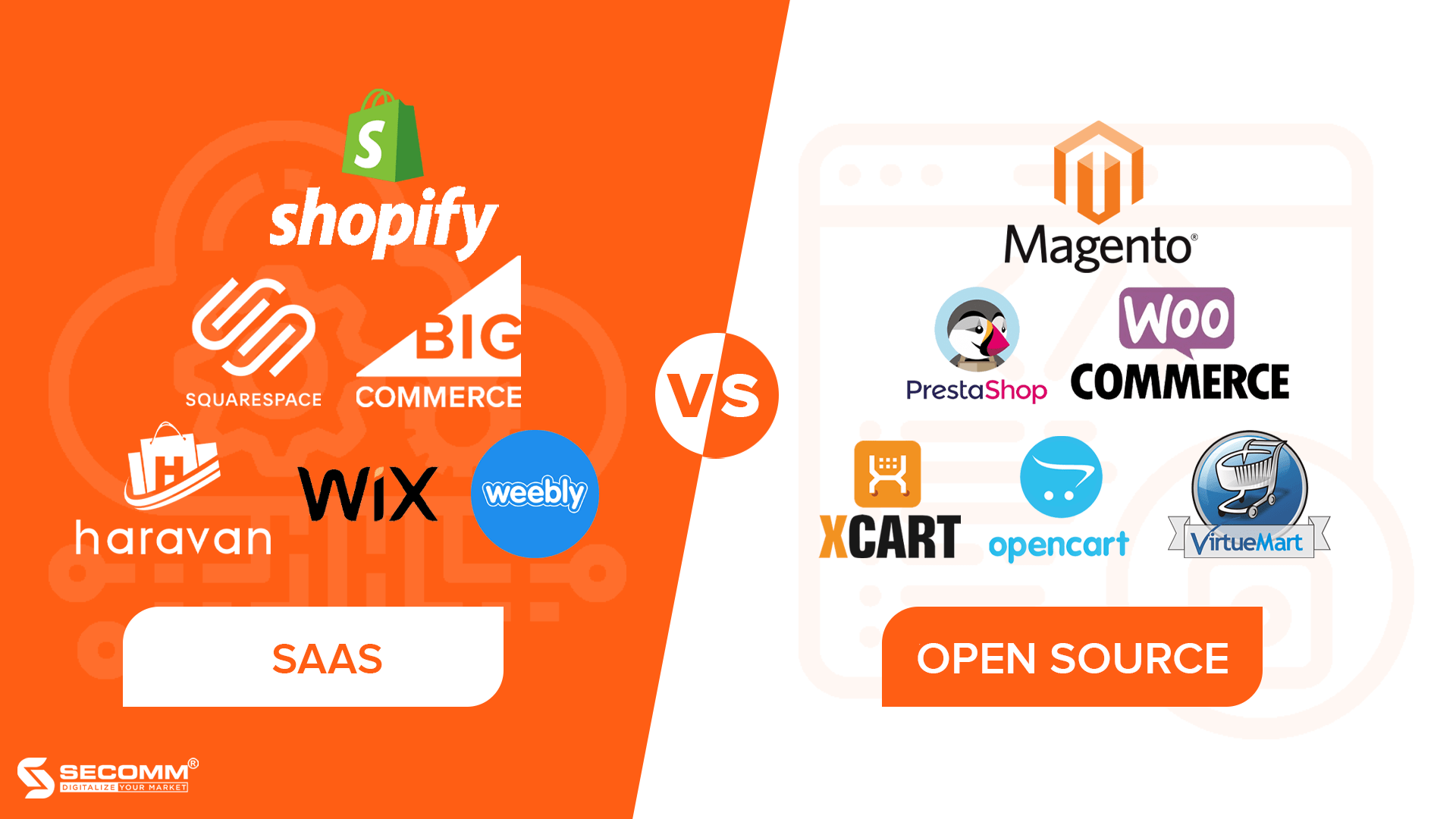
A SaaS eCommerce Platform is a service delivery paradigm for developing a software-based website system. Data is kept on the provider’s server system under this approach, and that platform is in charge of dealing with technical concerns for the business.
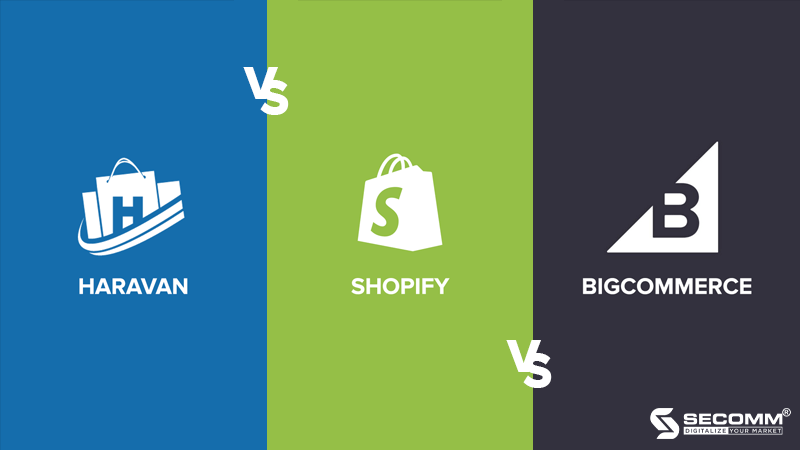
The provider pre-designs the SaaS platform for the full system, from hosting, interface, and features to technological infrastructure maintenance. As a result, organizations can quickly create and manage a website system without worrying about technological concerns.
Furthermore, the platform developer offers firms 24/7 assistance through live chat, desk help, or a hotline while the platform is in operation.
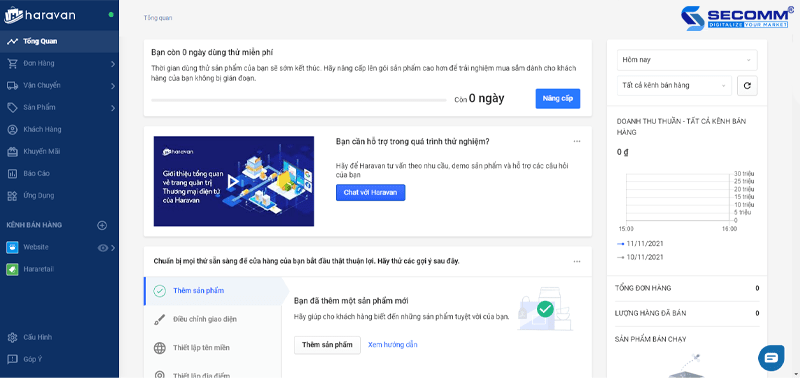
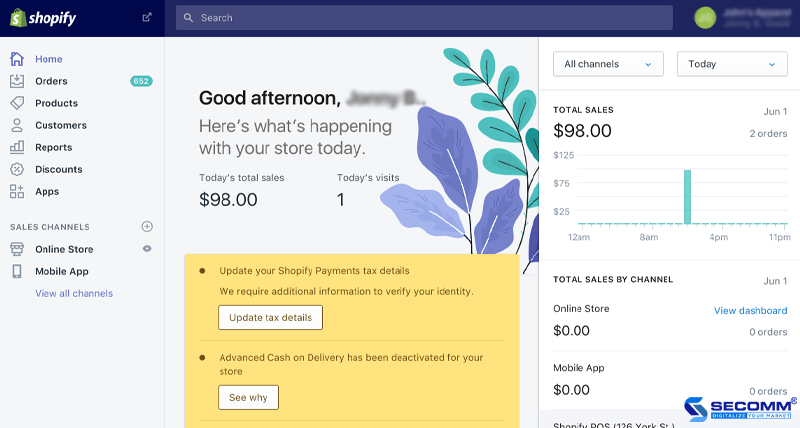
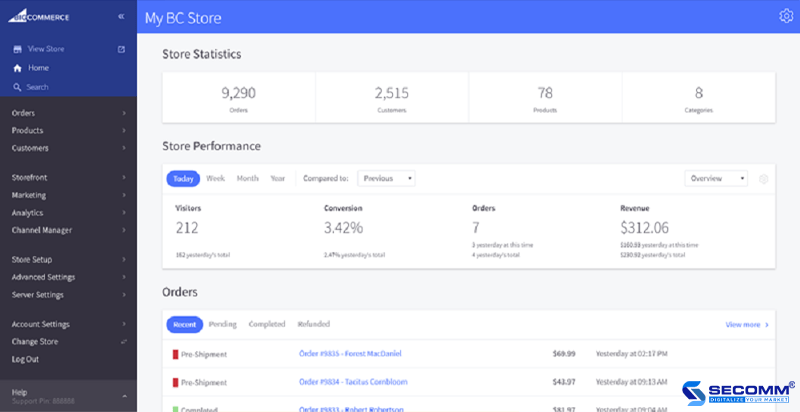
The SaaS eCommerce Platform includes a multitude of functionality and appealing UX/UI interfaces, making it suitable for a variety of businesses.
Furthermore, these platforms include a wide range of essential eCommerce functions, including product administration, order management, customer management, marketing, business analysis, and reporting to let firms quickly develop an e-commerce website. Moreover, extensions such as Omni-channel, Affiliate Marketing, E-Payment, E-Logistic, and so on are constantly added to these platforms to strengthen the e-commerce system.
The time it takes to establish a website on a SaaS eCommerce Platform is quite fast, ranging from 1 to 7 days on average, depending on the website’s setup.
The initial building cost is pretty cheap because firms would pay monthly or yearly use fees (subscription-based) to establish a website using SaaS eCommerce Platforms, such as:
Aside from the monthly/yearly licensing charge, businesses must pay extra expenditures such as interface fees, new features, expanding the number of backend users, and POS (Point of Sale) to grow the eCommerce system.
Because the enterprise’s whole website system is housed on the provider’s server, ownership and control of the website source code will belong to that platform, not the firm. Businesses who transfer platforms can no longer utilize the previous site source code and must rebuild from scratch on the new platform. Moreover, data loss or misalignment is usually unavoidable.
The enterprise’s data, like the source code, is likewise kept on the provider’s server, thus ownership and control over the data remains constrained. There are many difficulties for not owning and controlling data, such as linking data between departments, customizing users, and so on.
Because the website system depends on the SaaS platform, customization and expansion are currently limited. When it comes to upgrading existing features, developing new functions for the company’s development, in line with the particular requirements of the product and industry, and optimizing the user experience, SaaS platforms are frequently unable to adapt. As a result, switching platforms after a period of usage is unavoidable, and of course, this change will take significant time and money for the company.
Because you must pay monthly or yearly license fees, the longer you use the higher the overall cost of use. Furthermore, the SaaS eCommerce Platform charges on the revenue online sales.
For example, various Shopify apps, such as DCart (Create Discount Codes on Cart), OctaneAI (Similar Product Suggestions), Ali Reviews (Product Reviews), and others, would charge a monthly fee, average $10 /month/features. The more applications that are installed, the more the monthly or yearly expenses will be.
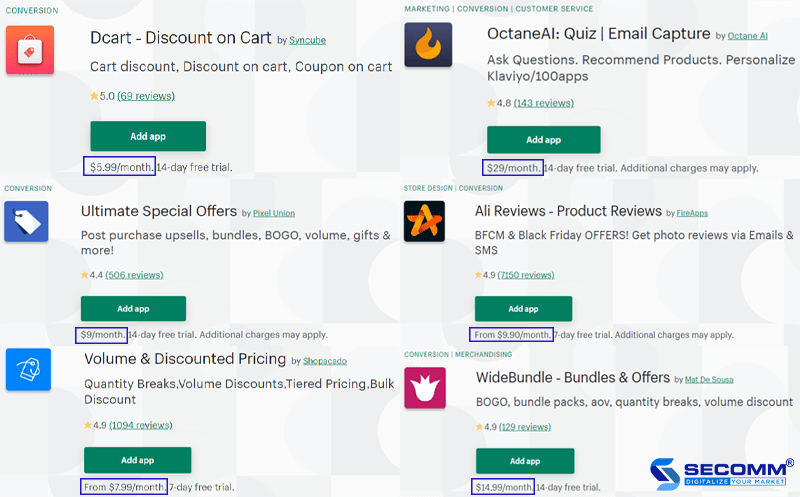
Businesses can use the SaaS platform if they wish to enter the e-commerce industry rapidly, have minimal need for customization, and do not need to enhance the system. As a result, SaaS systems are frequently selected by startups, SMEs (small and medium enterprises), and businesses just getting started in the e-commerce industry.
Open Source is software whose source code is publicly available and freely used by anyone.
Because the data and source code will be housed on a separate server system, Open Source eCommerce Platforms have the opposite aspects of SaaS platforms. Businesses that use open source platforms must collaborate with professional website developers or build a highly specialized in-house team for the website system to achieve maximum efficiency.
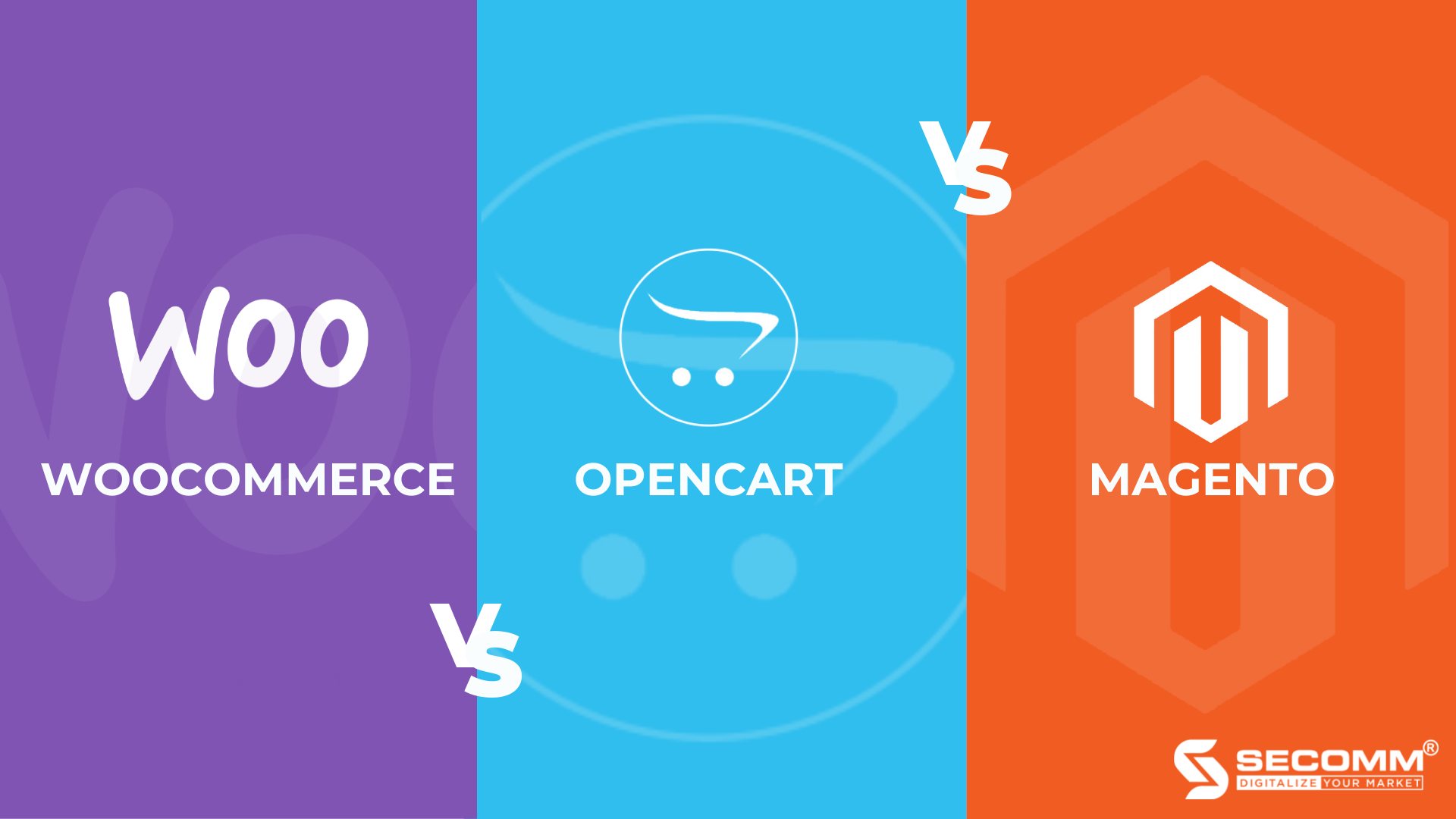
Businesses have complete ownership and control over the source code and data on the system due to the characteristic of being housed on a separate server system. As a consequence, while deploying an eCommerce website, companies only need to pay development expenses in order to utilize the source code, rather than monthly/yearly license fees just like SaaS platforms. At this point, you could reuse the previous source code if you change developers or platforms. Furthermore, security is improved, reducing hacker attacks, server failures, and technical faults from staff and consumers.

Businesses have more choices in developing their website’s interface to boost brand image and maximize revenue since they use Open Source eCommerce Platforms.
Currently, there are three methods for designing interfaces:
In terms of website system features, Open Source eCommerce Platforms are quite superior to SaaS platforms. Not only have basic functions, but Open Source eCommerce Platforms also have many advanced features such as quick search, similar product suggestions, abandoned cart notifications, real-time products, and so on.
In addition, the Open Source eCommerce Platforms also has many add-ons that are improved, provided, and shared by the developer community.
Because organizations control their own source code, they can simply update the functional system, build new features, or expand the system to suit business demands and meet consumer needs. At the same time, the open-source code’s flexibility allows businesses to easily link with third-party utilities in order to run the system.
It is hard to build “tailor-made” systems for each firm with a system of various e-commerce features ranging from basic to complex, therefore systems developed on open source e-commerce platforms frequently have high accuracy. As a result, in order to build and function efficiently, a specialized team or development organization must have strong knowledge and several years of experience.
Deployment times for open source e-commerce platforms are frequently lengthier than those for SaaS platforms. Depending on the complexity of the functional system, the average amount of time for the IT team to build a website varies from 3 months to 1 year.
Using an open-source platform is basically free, but having a full e-commerce system from website to mobile app needs a significant commitment of your own labor. The in-house IT team will design interfaces and functions. As a result, the initial cost of developing an e-commerce website using an open-source platform is pretty expensive, an average of $10,000 per project.

The Open Source eCommerce Platform is suited for all sorts of enterprises due to its numerous features. However, budget and implementation time restrictions have kept many small and medium-sized businesses from utilizing it. Large firms frequently engage in these platforms to construct specialized and specialized eCommerce systems.
In general, the decision of which eCommerce platform to select will be determined by each firm’s business plan, budget, and time of eCommerce development.
 2
2
 7,331
7,331
 0
0
 1
1
The market is the foundation for creating a business’s original values, deciding essential requirements and conditions a business needs to achieve to enter the stage of market presence. From then, customers with specific demands will choose to buy the items they want. The ultimate goal of a market is to meet the needs of commodity exchanges precisely. This process continuously compels businesses to maintain and update their business operations, immediately adapting to customer requirements and not falling behind other competitors in the same market.

The market helps businesses approach customer behaviors more deeply, which is very important in resource management. That also presents in data sources such as the number of selling goods, rising goods consumption, or figures showing a sharp drop in merchandise sales due to the disease’s impact. These factors will contribute to the next analysis steps from collected data, approach the operation process more accurately, simultaneously regulate the level of goods production to meet just enough customer needs, avoid goods-excess or -shortage.
A market will reflect the competitiveness, scale, and position of all businesses within the market-share concept. Determining market share will point out precisely the revenue dimension compared to other competitors, also contribute to research and development activities, clearly identify competitors, customers, strengths, weaknesses, and at the same time, aim for following strategies to improve or increase sales.
Under the control and dominance of a market, businesses also contribute their values to the general development custom, creating different development orientations and characteristics for each market type.
The competition among businesses promotes a much more vibrant market. It is also the driving force for enterprises to change and perfect day-to-day operating systems, update the trend not to fall behind other similar competitors, and finally optimize the customer experience.

Business growth expands the market dimension and stability. A speedily growing business will supply more substantial quantities of goods, focusing on research and improving goods quality. This approach will attract more potential customers; also new companies. The full penetration of market factors (sellers and buyers) concurrently affects the market size compared to a general economic picture.
Over 50% of companies are aware of the impact of the Industrial Revolution 4.0 and feel it is taking place day by day. However, more than 70% of businesses do not fully understand their technology systems’ status and have yet to ascertain where and when to start deploying digital transformation.
While many other companies have quickly grasped and implemented digital transformation strategies for a long time and achieved specific success in the market, most of the remaining companies struggled with financial and technological problems. That contrary also affects the market, makes it move slowly and miss technology updates. Therefore, to successfully digital-transform, the interactions between market and business should not be overlooked.

First, market and business must satisfy the fundamentals of digital transformation, including connectivity and a stable internet platform. Connectivity refers to connection size and speed. Connection needs will increase continuously in the future, allowing businesses and markets to ignore their customer networks’ connections.
Next, the connection speed needs to be improved to help data transmission and processing take place faster. Since ecommerce sites have become more and more popular, customers have more options when shopping, and there is no reason to waste time waiting for a too slow-speed website. That is why the Internet platform is a vital imperative requirement to promptly meet the needs of markets, businesses, and users in the digital age. The Internet has become an essential part of daily life and a cornerstone facilitating the digital transformation process, promoting innovation, creativity, and new technology applications to the existing civilization.
Besides, focusing attention on improving digital skills for human resources is also a way to tighten the interactions between market and business. Digital transformation tends to impact old business models to upgrade and improve them into leaner and much more modern models. That prediction significantly affects human resources when some jobs have been automated and operated by artificial intelligence without humans. However, these automation jobs can produce more brand-new alternative jobs, namely quality management, market research and development, and product development.
Nevertheless, at the same time, it also raises the requirement to improve the capacity and digital skills of all existing human resources. Information technology skills have gradually become an essential condition for each individual to fully meet the labour market’s basic needs, especially when ecommerce becomes a trend worldwide. However, the ecommerce market also needs to improve data security issues, logistics, and payment security to gain the highest trust from customers and further development in the future.
The interactions between market and business are often subject to significant impacts from common development tendencies, technological advancements, and other digital transformation issues that make sense to be continuously updated and changed procedures to suffice customer needs and experience. Within those interactions, businesses will perform digital transformation responsibilities from the market requirements and vice versa; the market is the environment showing the exact business outcomes. When having reached the capacity and position, businesses can create a different market themselves with a stable and sustainable customer source.
 2
2
 6,679
6,679
 1
1
 1
1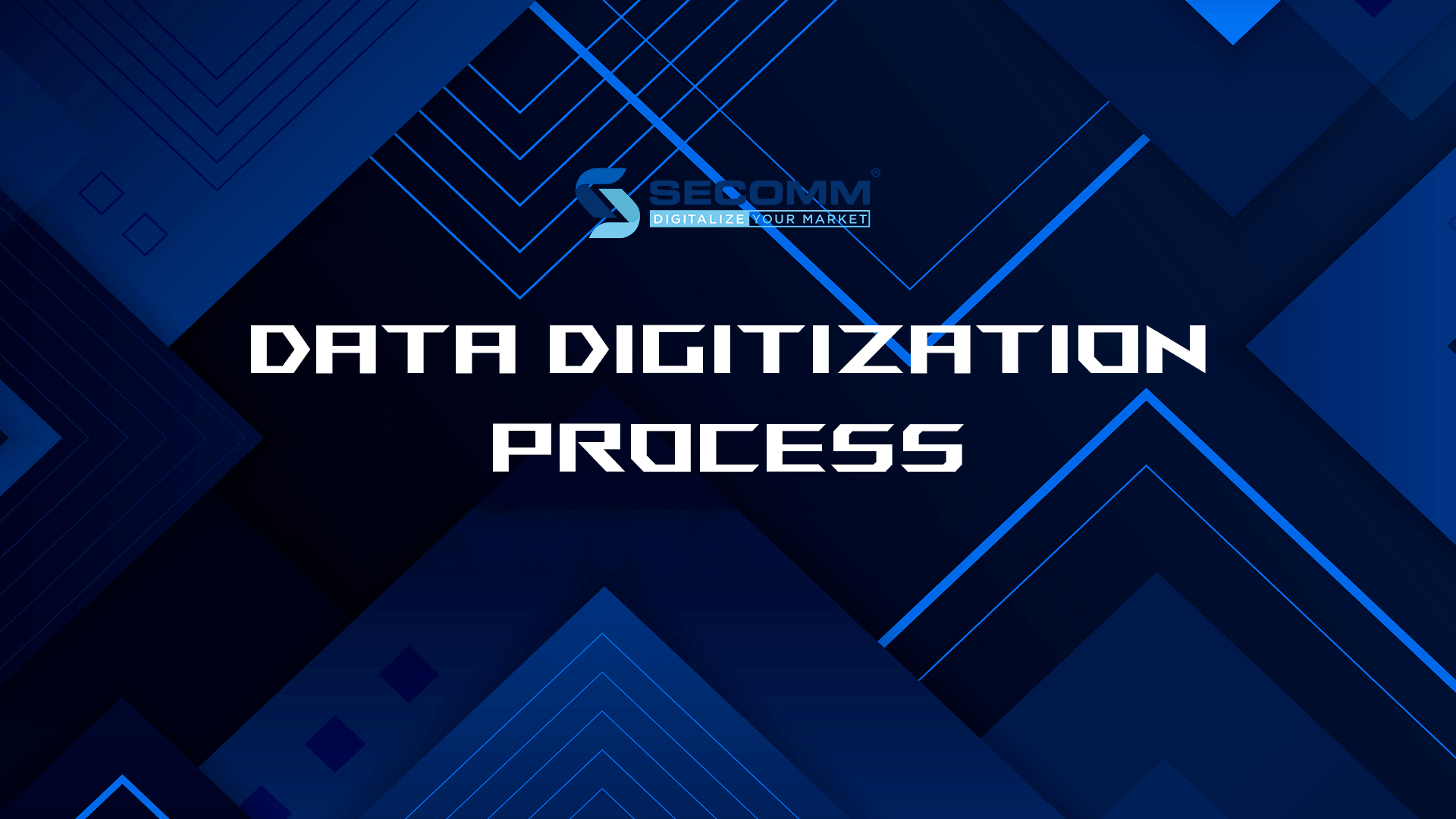
Data digitization is a data-transforming process from traditional paperwork to digital format databases. After digitization comes to completion, the database will be stored and managed by software or technology platforms, enhancing this data system’s security and accessibility.
This enhancement is an obligatory transformation requirement for traditional business models as most businesses face operational and management problems. At the same time, start-ups already can access new technologies and have a more modern changing mindset.
First things first, there are many difficulties in storing and preserving paper-printed documents. They are often bound to form in book-types with large sizes. Secondly, paperwork makes searching, synthesizing, and analyzing unnecessary time-consuming.
Meanwhile, digital data sources can streamline the bulk of previous paperwork while still having enough digital space to store in the data systems. Those systems especially have many advantages about security and flexibility in supporting data analysis and research for business development strategies.
An essential data digitization process goes through 3 main stages: data classification, format conversion, storage, and management.
To fully prepare for a digital data plan, businesses can start by sorting and sifting through document types according to digitalization objectives and strategies. Specifically, retailers can prioritize the data of products, inventory, customer information, or ordering reports. Besides, operating-oriented businesses may consider using internal data sources for in-house working and managing processes such as accounting data, factory data, operating records, and other related types.

In the next conversion step, paper documents will be scanned and converted to image sources such as JPG, TIFF, GIF, PNG, RAW… With a much more improved budget, an organization can take advantage of more breakthrough technologies, namely AI, Machine Learning, Big Data… to digitize paper-printed data into editable formats. The data will then become streamlined and stored in data systems for the later exploiting and editing objectives.
The benefits of digital data management systems are the minimization of storing space and cost, access time, operation, and management costs, simultaneously providing the optimization of security and data mining performance. These systems operate under two main requirements: the first is to store, the second is to support data access flexibly and quickly.
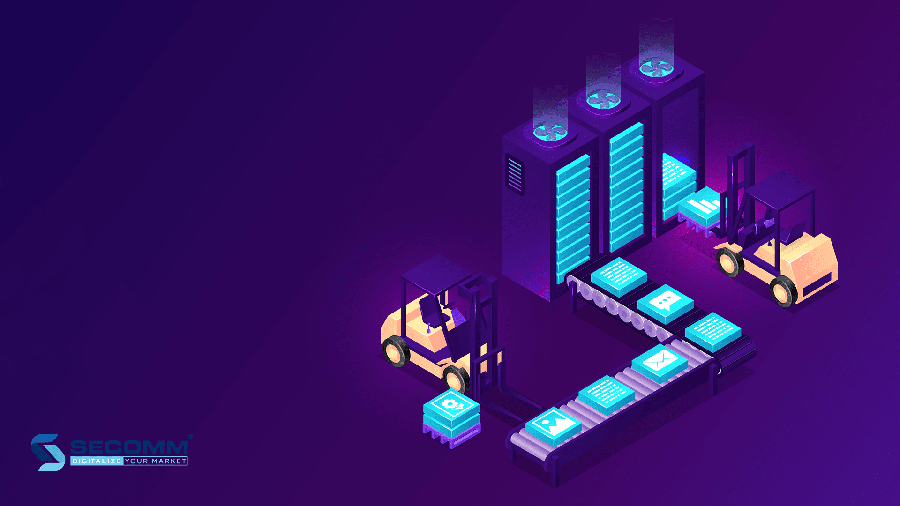
One of the essential tasks is to use the right technology at a particular milestone to optimize the process’s quality and time. When matching both the above requirements, businesses no longer need to worry about the budget-exceeds anymore.
Solutions for data digitization processes will be much more comprehensive by using digital data management systems tailored to the data storage and access needs. Businesses also easily use data for business research and development objectives, improve products, service quality, or produce brand-new products and services to meet customer demands. Essentially, digital data management systems can:
One of the most popular digital data management platforms is ERP systems. ERP contributes to being an entire enterprise management system capable of using data as a business operation resource.

In particular, ERP creates a high-logical storage arrangement for all business departments to develop the ability to seamlessly and quickly access, usage, and exploit information. However, ERP is a comprehensive transformation that requires businesses to accept innovation significantly and reform the traditional operating model.
Data digitization can also be effectively applied in national public services, forming e-government to transform the traditional administrative environment’s working process. E-government creation brings a massive advantage for both the government and the citizens when managerial procedures become faster and more flexible.
Also, information and data sources in the electronic management environment are more secure, safe, and transparent. A typical example of this strength is the blockchain application in managing the e-tax system of an enterprise. Blockchain possesses a significant advantage in data security, and value-added tax transactions are also real-time done quickly, minimizing fraud and tax evasion.

Another data digitization case study is the accelerated development of retail technology applications by Saigon Co.op. With the most astounding purpose of optimizing the customer experience, this retailer aims to partner with leading technology businesses to create a digital shopping space.
As a result, the cooperation with Momo wallet has got implementation, and the brand has become the principal e-payment method in supermarkets. The combination with the Grab delivery system is also an essential breakthrough, promising GrabExpress freight forwarding services and food delivery GrabFood applied to the entire structure of Co.opmart, Co.opXtra in Ho Chi Minh City.
However, these successful case studies in typical pioneers’ digitization process do not mean that formula will bring absolute success for almost all businesses. Data digitization strategies mostly depend on external factors. They are even contingent on business demands. That is the reason why companies need to tailor standard processes and systems before conducting data digitization.
Digital transformation is an essential process of multiple scales, in which digitization is only a small layer. However, this layer is a critical core value of the whole digital transformation process.
Data digitization gives businesses many significant advantages to meet the digital transformation process’s basic requirements, converting the format of data platforms. Forms of storing and managing data are also quite diverse, and businesses can choose the right way to manage their digital data sources.
However, technology is not the main factor for success, so is multiple platforms usage. Considering the correct strategies, data systems based on appropriate technology platforms will lead businesses closer to expected results.
 2
2
 7,022
7,022
 2
2
 1
1
Digital transformation is a necessary process for traditional business models to keep pace with technologies and times. Implementing DT that is suitable for each of the businesses will increase its competitiveness in the market, thereby increasing revenue while optimizing the operation process, creating values for corporate culture and human resources. A complete DT model is a three-layered design: data, process, and business model.
The data layer is necessary to digitize data sources by using technologies for easy-management. A business will implement transformative strategies for operational processes based on transformed data in the process and model layer. Companies can change their models to suit the prolonged orientation and develop corporate culture more extensively. They can also conduct step-by-step or simultaneously implement all the layers if there is a suitable option with the business requirements and specific transformation strategies in both the short and long-term.
Data digitization is transforming from paper-works to digital formats and then storing the digital database in computerized data management systems. Those systems are made up of the technology-implementation to store data intelligently, making data retrieval more manageable and faster. Therefore, data becomes more proactive and brings substantial value-in-use to the business.
Data digitization will create a more seamless working process while ensuring strictly systematic and complete data sources, building a comprehensive digital infrastructure for businesses. It simultaneously is the digital transformation process’s kernel, forming the foundation for all the remaining layers. Up to now, data digitization is an optimal solution ensuring the integrity and security of data systems in the long run, which significantly reduces operating costs.
Additionally, database management systems are the most critical archives that can maximize data access and exploitation efficiency. MySQL is an excellent example among the most popular DMS today, owning multiple useful features based on open source code while ensuring data speed and safety, even large-capacity data systems in the ecommerce field. Accompanying other DMS such as SQL Server, Oracle, PostgreSQL, MySQL can meet most of the data-usage requirements of storage performance, security, and data-safety standards.
These outstanding advantages help MySQL get more appreciation from technological experts by implementing them in many highly-complex technology industries.
Based on the digital data’s core, the process and business model digitalization form a more widespread layer covering the core inside. This classification is highly complex and embraces various forms depending on the operations’ ways and objectives. PMD refers to the transformation relying on technology infrastructures and digital data frameworks to form a digital platform.
To complete the digitalization is to analyze issues in operating processes and business models. From an in-depth analysis, they can provide the right direction and strategy for transformation decisions. This transformation layer has supported businesses to meet the DT requirements, which fully are:
At the same time, a business needs to combine digital solutions to create customer values and build operating models.
Currently, businesses have successfully applied CRM platforms or ERP systems to optimize operational processes in terms of time and resources. It is well-known management platforms such as Zoho CRM, Microsoft Dynamics CRM, or Salesforce CRM that almost all businesses implement for stable development. Those names are tremendous supporting tools to create the business departments’ continuity of processes and operational processes.
Both CRM or ERP systems effectively help businesses achieve targeted sales and effectively disentangle complex manual processes or issues related to data controllability and preservation.

Digital transformation (DT) is the largest category, the complete model to bring businesses closer to the 4.0 digital economy. DT represents the whole process of digitizing data and digitalizing operating processes, business models. DT’s ultimate goal is people-orientation, and at the same time, combining the corporate culture with the customer-centric foundation. DT sets macro-objectives of people’s direction in building strategies, corporate culture, digital technologies, and adapting to these digital transformations.
Generally, most companies carrying out DT encounter significant barriers. They frequently ignore a complete data digitization plan while only focusing on refining more macro-plans in the process and model digitalization layer, which does not bring the high-volume transformation effect due to the initial preparing step not been done thoroughly.
Also, preliminary estimates of time and the limited budget will present a significant challenge for DT tasks in specific periods. Multiples of businesses are unable to catch the expected results. However, despite the existing challenges that they have confronted recently (the COVID-19 crisis), digital transformation will provide comprehensive support on data systems and digital platforms, exclude all social distances, and connect the world easily anytime.
The digital transformation process has made both efficiency and sales for numerous B2C and B2B businesses. In detail, ecommerce is the most typical manifestation, having recorded impressive growth since 2017. B2C companies have also strengthened the development of a more powerful ecommerce channel than ever.
Meanwhile, B2B models pay much more attention to transforming chains/systems/processes such as production or goods distribution processes by gradually turning into online methods to adapt to the flexibility and rapidity of the 4.0 supply chain.

Up to now, ecommerce can be considered as the complete performance of the digital transformation process. Ecommerce channels can update information quickly and continuously while also ensuring UI/UX optimization to provide perfect user experience, excellent customer experience, and as a result, increase sales. These are also the requirements to digitalize the markets and perfect the business’ operating system. Depending on the DT objectives, the company will stop at the stage that best suits its business model. Some of the businesses only need to digitize data for more effortless operation.
However, from a much more general perspective, almost all companies convert to an ecommerce system to control their business independently and connect directly with customers, partners and come closer to the DT outcomes. Those objectives are also the straightforward development orientation of most retailers today. They focus abundant resources on developing the ecommerce channel to expand the business scale.
For instance, The Coffee House is a case study of the F&B industry’s impressive DT outcomes in Vietnam. The brand has achieved their ordering application for more intensive data resource management and operation. This application was initially built on a requirement to increase the loyalty program’s ease and improve customer care service quality.
However, until now, this sales channel has grown more than that and has become a mainstream business channel that seamlessly integrates with the brand’s existing offline stores.
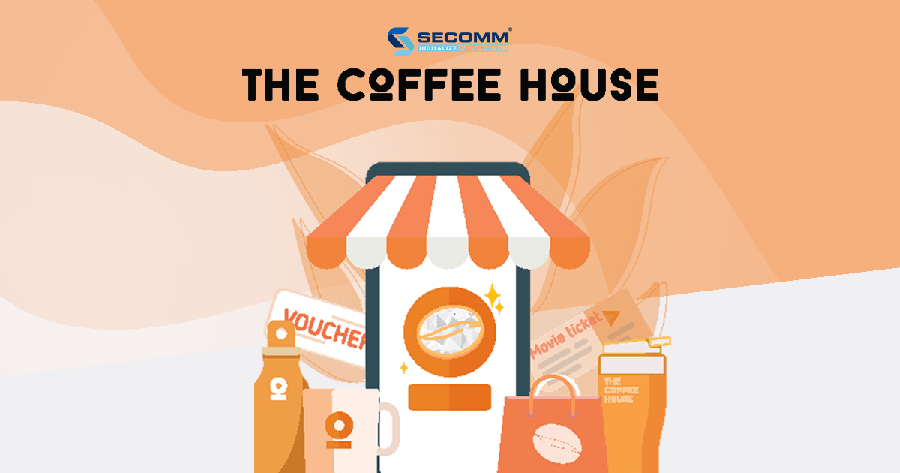
The TCH app aims to connect and interact directly with customers based on the D2C model, allowing app-users to create membership accounts to earn points and order quickly. These features allow brands to access customer data and shopping habits easily. In-depth data analysis will contribute to new product strategies or menu amendments to better suit the customer’s taste.
Digital transformation is a long-term journey that needs to be done with a detailed and complete strategy while meeting the time and budget, matching the current business’s capabilities. Digitization/digitalization layers also need to fully play their role in digital platforms, transforming entirely and efficiently. A complete ecommerce system considerations are also required for supply chains currently in the marketplace. Ecommerce will be the most agile driver of digital transformation; however, make sure that you can implement a strategy with the right priority in the current situation to give the best effect.
 2
2
 9,029
9,029
 3
3
 1
1
Traditional shopping refers to the way customers directly buy products at stores, markets, or supermarkets. Since that trading model has emerged, the ecommerce experience about products has often originated from direct product-observation and -interaction. A consumer can hold and touch the item directly, feeling its characteristics, such as hardness, softness, size, or even color. They can quickly try one dress and exchange another one for a suitable size. This model has several benefits for shoppers:

The benefits of experiencing products with traditional models will have many changes in online shopping models. Although customers will enjoy the convenience of freely choosing a suitable item in a wide range of goods at more bargained prices and also experience regular promotions, the limited interaction with the product pre-buying has reduced the convenience as the traditional model did before.
With the rapid development of the digital age, customer demand is a critical factor that is a priority in every development strategy and orientation. In particular, businesses also invest more in modern technologies to optimize consumer-product interaction, and AI applications are a useful option for ecommerce experience optimization process.
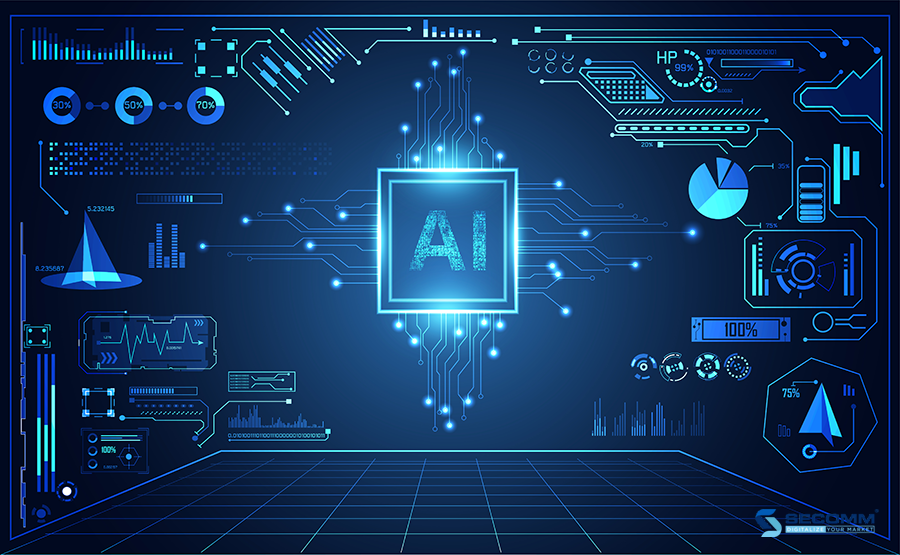
Within the Ecommerce field, AI aims to the product experience, contributing to the efficiency of the business’s customer-centric orientation. The AI application has been integrated into search engine systems to support the creative and effective searching process with features such as “search by image” associating with material, shape, size, or brand. The display technology also invests in improving product interaction, shortening the distance between online and offline models.
Moreover, AI supports the ecommerce industry as a knowledgeable online assistant. This technology can bring two-way benefits when supporting both user experience and data analysis about user behavior trends.
Those are the two factors motivating brands to invest in developing more modern and efficient AI platforms towards a smarter, automated model for perfect customer experience.
Since applying to the ecommerce industry, various AI technology types have contributed to significantly changing consumer habits and purchasing decision-making processes, ultimately optimizing the convenience that customers received from online shopping. However, AI tools are continually developing and improving every day to enhance the user experience, and they also regularly stay updated with many popular trends.
The 3D formats have been practical to enhance more excited customer-product interactions. Customers can observe different product aspects or even try placing a small decoration item at any house location to check the product’s suitability. This invisibility generally creates exciting experiences to increase interaction making customers more interested in the product.

Some interior brands have been using 3D scanning technology to perfectly experience interior space and architecture. Based on a provided video, customers can enjoy AR via remotely 3D virtual reality technology.
That AI ability can be a perfect solution when a store has too many customers visiting at the same time while the fitting room is overloaded. Customers can scan product images and try them out on a mobile phone screen. This technology is already available on Lacoste’s app, supporting customers to try their favorite shoes freely via their smartphone.

The development of 3D and virtual reality technology has proved that nothing is impossible in the digital age. AI development is also a considerable solution for ecommerce barriers, mainly interacting with products when buying online to optimize ecommerce experience.
In the future, as many expert predictions, AI can be a modern and popular trend to optimize the ecommerce experience correctly. However, businesses also need to consider the needs of target customers to have appropriate applications and increase the number of potential customers and loyal customers in the long run.
 2
2
 4,218
4,218
 1
1
 1
1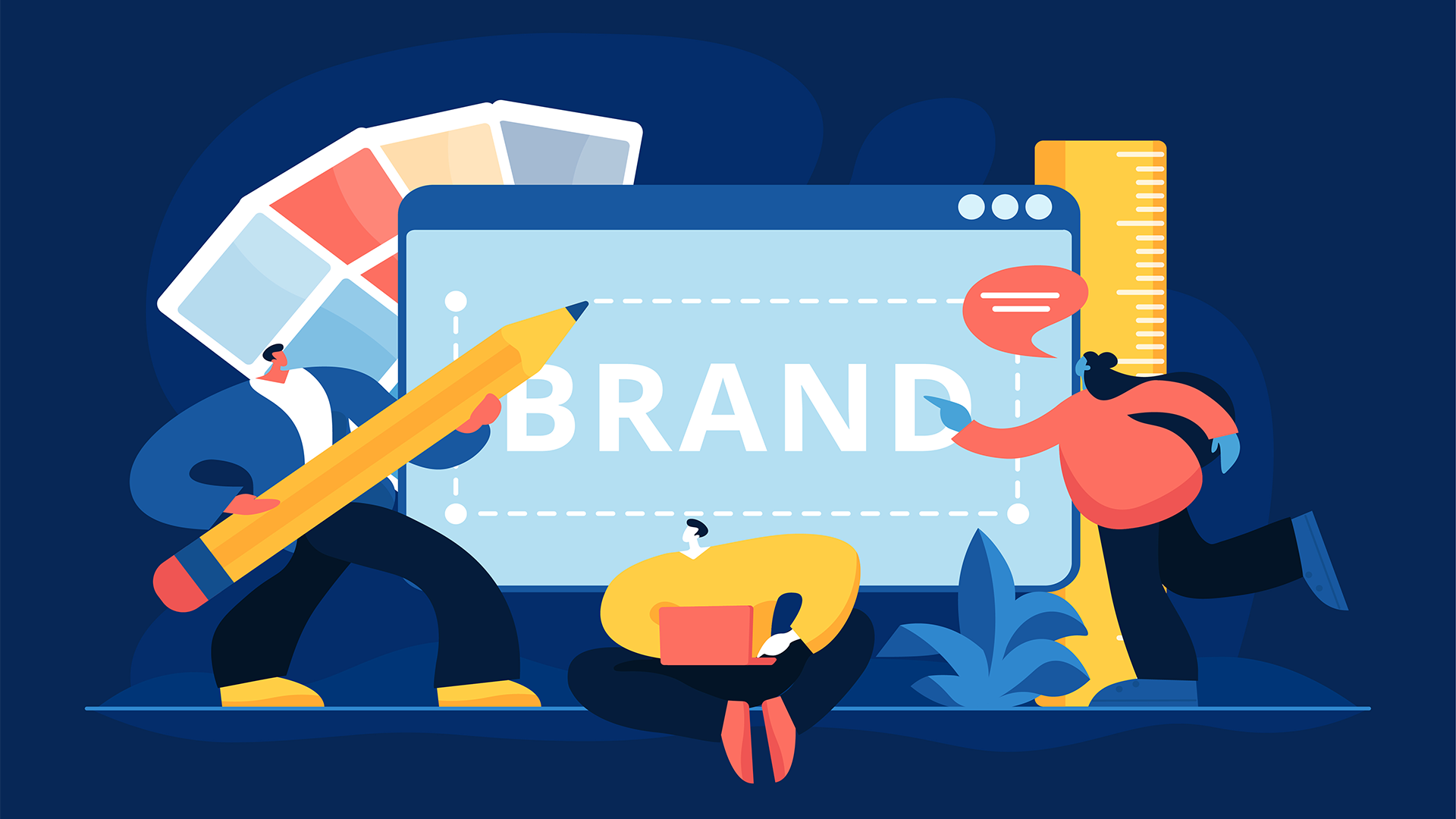
The first two common concepts of a brand are the confusion between brand awareness and brand identity when it comes to brands. The biggest problem here is, most people use them, assuming that they have the same meaning and have complementary relationships. However, the simple truth is scopes of these two concepts are entirely different, including how they create awareness and identification values.
Brand identity is a way to identify a brand in the public’s mind, using materials such as logo, slogan, company profile, design style, name card, brochure, and even colors across their designs. Brand identity usually starts from the brand’s values to create the first impressions and memories in the customers’ mindset. Among the concepts of a brand, brand identity can do more than as a brand face; it makes the brand memorable, creates a position for the brand in the market, and creates a particular attraction when the brand publishes an advertisement.

In Vietnam, Coca-Cola often appears on holidays, important occasions with two primary red-white colors and unique handwritten fonts. This brand always communicates to the public the values of reunion, family affection, inspiring people not to forget where they belong. Another example is the Apple logo’s story performing the image of “an apple with a bite” has a strong desire to reach perfect, rebellious, and unique values.
All the elements that appear, more or less, convey a specific aspect of brand value, vision, and mission. They also contribute to creating the unique memories that customers experience with the brand and stimulating closer connections.
Brand awareness is the result of creating a set of values to make a brand different and essential. Awareness implies the mindset, perspectives of the brand’s role to customers and other market competitors.
To build a brand awareness process is to focus on connections and interactions mostly. However, it is first necessary to create an information platform that helps the audience get the whole picture of a brand. In particular, the crucial factors that can make this process done are content platform, product/service platform, and human factors.

Content has a great ability to create a brand’s tone and voice while also shaping its style. This ability allows brands to set perspective and the appropriate direction usefully, similar to how Redbull conveys the messages from the “Give you wings” campaign with the desire to become the dream-maker.
On the other hand, product quality also dramatically affects the brand. Product quality is the launchpad for the next PR or marketing campaigns, but an inferior-quality product will make the brand fail no matter how good those campaigns are.
Starbucks has gone beyond the limits of a coffee shop with increasingly appreciated values. However, when it comes to Starbucks, everyone is pleased with almost all the drinks here. The excellent taste of the beverage menu has attracted and kept more customers.
Coca-Cola gets a very high level of brand awareness when almost 90% of the world population knows what Coca-Cola is. Like many other long-standing brands, Coca-Cola has created a cohesive consumer habit that can retain generation-to-generation and refreshed itself by creative advertising campaigns that add more imprints to customers’ mindsets. Did you remember the Coke bottle had your name printed? Have you ever taken a selfie with it? Yes, these name-bottles are part of the “Share A Coke” campaign – a campaign to help Coca Cola to surpass Samsung, to win the Gold Award – Brand Awareness category at The Smarties Vietnam 2015 (organized by Mobile Marketing Association in Vietnam to honor the best brands and agencies).
In another context, to maintain the identity values of perfection, rebellion, and uniqueness, Apple built its own extremely discriminating cognitive system. The brand does not narrow itself to any target market but towards a design that is everyone-friendly. It forms a unified brand culture from the inside out, including creativity and simplicity. Apple ignores the trends and competitions; it contrarily produces themed devices, generating new patterns for other brands in the technology market.
In general, brand identity emphasizes feelings of “love at first sight”. This concept tailors the brand’s face, helping customers classify the brand’s identity, functions, roles, and products. On the other hand, brand awareness conveys long-term values, internal values, and different values remaining in customers after using a brand’s products or services.
Those two concepts of a brand are not synonymous and equivalent, and brand identity is a part of a brand awareness strategy.
Among the concepts of a brand, brand positioning models have been diverse, from the Minimal Viable Brand model provided by Eric Ries to much more complex models, namely the Brand Key (by Unilever) or Brand Pyramid (provided by Keller). There is a common-sense between these positioning models, which is the forming and maintaining values, from the root strength to the brand essence, which can eventually be long-lasting in the community’s mindset from generation to generation.
Usually, we are aware of the elements of visible benefits and measurable values. However, brands that leave an in-depth impression in the customer’s mindset create subjective and sensory values. Therefore, the positioning process worth considering includes discrimination and customer experience as well. Also, emotional and personal factors often require a high level of two-way interaction between both brands and customers, in general.

Discriminations refer to values making a brand different from its competitors. You can use product strengths, brand stories, or media messages to emphasize how you are different from dozens, hundreds of brands in the same field. A coffee shop with a mountain-view will be more attractive than another with small tables in 4 tight walls. Of course, the very first goal of people coming to a coffee shop is to drink coffee; however, gradually, people need more than a coffee cup when coming to the shop, such as to talk and discuss together, to work, to have group meetings, to take photos, or even dating.
People tend to be more interested in which coffee shop is suitable for taking pictures, which are tranquil enough for working. A tasty coffee-cup is one of the different values making customers frequent more; besides, people also care about the space, décor, view, etc.
Another fundamentally important factor for a branding campaign is customer experience. Experience is truly the accompanying actions or services, making customers feel they have received the attention and devotion when using certain products or services. Customer experience is one source of developing brand touchpoints and including various concepts of expertise, such as interface experience, shopping experience, or product experience of a brand.
Apple has successfully satisfied their customer experiences by designing an intelligent technology product-ecosystem to meet the seamless connection and interactions between devices and people, creating convenience and ease. Therefore, besides the brand itself’s discriminations, an excellent customer experience will be an active element for branding.
The digital age has witnessed a transformation of the brand-value system and concepts of a brand when almost all the customers are much more interested in sensory factors like emotional experience when using products. That experience requires brands to keep up with customers’ insight, creating compelling content to obtain customers’ trust.
Why is brand voice important? Because it can speak up almost all the values of a brand and directly affect its audience. Voice can help personalize the brand, let itself create personality, and speak up as a human. As one of the key concepts of a brand, that is the most basic visualization of brand voice. However, brand voice is the element synchronizing and positioning brands at a higher level, shaping the brand identity and awareness. As a result, brands know what and how to reach the right audience target or market, developing both content styles and operation models consistently.
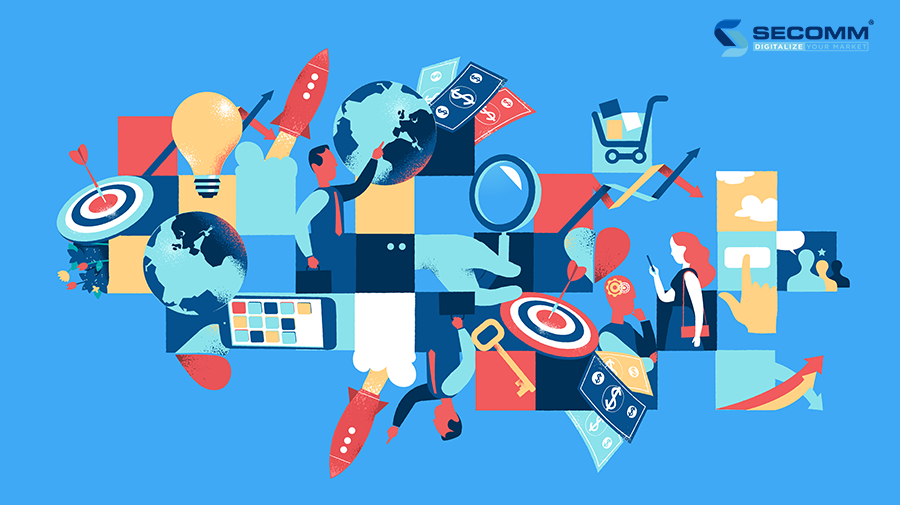
We remember Pepsi as a symbol of dynamism, youthfulness, and positive energy. On the other side, Coca-Cola is reminiscent of family reunions, cozy and fun spaces. While Apple emphasizes the simplicity and quality of the product system, Samsung focuses much more on diversity and stunning design. These differences show that every single brand shapes the growing direction with unique concepts, then they will record in the user’s mindset of distinct characteristics and styles.
Whether branding is minimalist or sophisticated, businesses need to fully meet the most fundamental concepts of a brand to increase communication and interaction with their customers. Simultaneously, it is necessary to follow appropriate values integrating with development orientation to avoid overuse, and confusion, which then losing the discriminations brands want to convey.
 2
2
 7,343
7,343
 14
14
 3
3
Customer-centric orientation can significantly improve the problems that consumers are suffering from shopping online. This orientation is correctly a long-term process to breakthrough ecommerce barriers, follows the business for a lifetime, creates brand values as a result, and other measurable values, such as highly-appreciated customer feedback, increasing the number of products sold.
At first glance, customer-centric orientation looks quite general and tends to imply intangible values. However, the “customer-in-center” mindset can generate both cognitive and measurable values. Before it can create measurable values, the business needs to have a clear awareness and specific purpose of this orientation, maintaining it as a unified business culture.

To get started, be customer-friendly in all aspects—organizations at first need to analyze the customer community’s needs and insights. Customer feedback, including limitations from existing products/services on the market, service quality, promotion campaigns, is the foremost factor to consider. Proactively getting customer feedback on products and services is all valuable information; thus, organizations will have time to complete both product systems and customer service.
It is an equally critical factor that improving user interface can produce oriented rather than product-centric. Many businesses assumed that the “good wine needs no bush” developing style would naturally create attraction itself. Indeed, this style is not wrong; however, it is still not powerful enough in the long run. Proactively taking care of customers, receiving the limitations of existing products are the fastest steps to improve producing more appropriate products. Products tailored to the needs make customers perfectly comfortable in the user experience.
To breakthrough ecommerce barriers effectively, one of the critical things is to set clear business goals. It is difficult to predict future fluctuations; however, proactively create realistic goals and prepare everything to achieve them. Businesses can start from their monthly goals about the cost, revenue, or market share achieved, then set out tasks to achieve the goal instead of declaring the whole year’s goals with an incredible number that no one could ever reach.

Besides, sales goals can give great support to an organization’s financial problem. In particular, the cash-flow factor should not become the only weapon that businesses abuse to invest endless-capital for ecommerce races. The fact has proved that enormous capital investments have made a large number of SMEs miserable. Meanwhile, ecommerce giants have received sponsorship from well-known global ecommerce organizations. They have been ready to run.
The ecommerce market needs to tighten product policies to deal more effectively with fake or low inferior quality products. This reason is the most significant issue without any practical solutions, and it also comes from both sellers, ecommerce enterprises, and consumers. Vendors are for-profit; businesses cannot control the stores; consumers prefer low prices despite good-quality; all of them are potential factors making the issue of fake goods, counterfeit goods more widespread.
To temporarily deal with the issue of inferior quality goods, it is necessary to focus on developing return and exchange policies and accompanying preferential policies. Businesses should quickly recall counterfeit or error products if the customer has received the product, give back customers an authentic one, and may come with a discount voucher for the next purchase. This reaction shows the attitude of the proactive settlement of businesses, as well as keeps customers calm.

On the other hand, to maintain the product and brand values in the long term, there should be a permanent policy in product quality assurance, product censorship policy before officially selling products online—for example, the ecommerce website TIKI.VN has done well when ready to commit a 111% refund if found counterfeit, simultaneously also completed the product quality assurance process before officially opening for sale on the website.
Additionally, other ecommerce businesses also make commitments to supply genuine products much more firmly. However, this is just an effort from one side; ecommerce businesses can only fulfill their role and work to ease the issues, not the most radical solution because counterfeit or inferior quality goods had originated from when traditional trading existed. In terms of a holistic approach, significant efforts from every consumer are essential, in other words, personal consciousness. This effort is quite complicated and needs to come first from the family and society’s educational process to form consciousness in human growth and personal development.
A high sense of quality will be the most comprehensive solution, whether from consumers, sellers, or businesses, which can then create more weighty policies that maximally protect consumers’ interests not only in ecommerce but also in all other economic sectors. Comprehensive policies will significantly eliminate inferior quality goods step by step to breakthrough ecommerce barriers.
Customers, cash flow, and product quality are the keys to determining the success of an ecommerce system, also affecting many other aspects. Therefore, to do breakthrough ecommerce barriers is to come first from the leading foundations and create synergy for removing existing barriers.
 2
2
 3,941
3,941
 0
0
 1
1
With no exception, brands transform as always to keep up with the digital age’s swift trends. To complete the digital transformation, investing in brand touchpoints is a concept that worth-considering. Most generally, the brand touchpoint is the simultaneous interference from both businesses and customers, creating the highest attraction for the business and providing the best customer experience.
However, some people argue that the concept of brand-touchpoint is vague and quite broad because any existing factors can potentially affect the movement of brand touchpoint for better or worse. This argument will be recognized if businesses do not know where to start creating a touchpoint. Brand touchpoints stem from business core-values, the level of customer experience, and a little bit of difference when needed.
System assets help businesses grow in both quantity and quality. A standardized system not only allows products to shape within the unified normative framework but also ancillary services. A complete digital transformation of a brand does not stop at the product level. Developing and continuously improving the system are the keys to meet the second requirement of the brand touchpoint: user experience. The apt system helps businesses get in touch with product-and-service convenience and can create an isolated ecosystem to make brands transform.

That was how Apple had been successfully producing a technology-product ecosystem that made a stunning attraction for users. Simply put, the term ecosystem in this context implies a group of products that can interact with each other in harmony to optimize customers’ convenience. Apple has generated an almost-efficient technology ecosystem that performs seamless interactions. However, what makes Apple enthusiasts completely satisfied is the personal ID system with high privacy and data security.
To take another example, Nike has wholly changed their business since their growth stalled, and the earlier business model was no longer sufficient. The mandatory change in the brand requirements has shifted to using an online business network to interact directly with consumers. The online trading system completely replaces the traditional product-distribution through intermediaries, as well as exclusive distributors. Nike also combines the accompanying member programs with trendy and fashionable items, creating a close connection with customers. As a result, the transforming system contributed to an increase in ecommerce revenue by 38% in November 2019 (data provided by Brands Vietnam).
To transform successfully in the digital age, make sure that the brand is honest and authentic. All information about the business can be delivered more quickly than ever in the internet era. A restaurant with a 1-star review will undoubtedly make customers turn away. Therefore, providing authentic information will make users feel secure and reliable when using products. Brand honesty helps create a pure life for products while contributing to the user experience’s seamlessness, making the brand touchpoint in harmony. Transparency in product quality and working manner will create a unique touchpoint system.
That viewpoint may sound strange, but most customers in the digital age need simpler products, services than cumbersome and complicated ones. Simplicity and minimalism in branding still can create brand touchpoints while focusing on the pillar values of the brand, such as strengths, target customers, differentiation, missions, quality, and messages. These keys, eliminating other complex elements, will be more focused and orientated for businesses in the long run. Simplicity and minimalism make businesses quickly adapt to the ever-changing digital age.
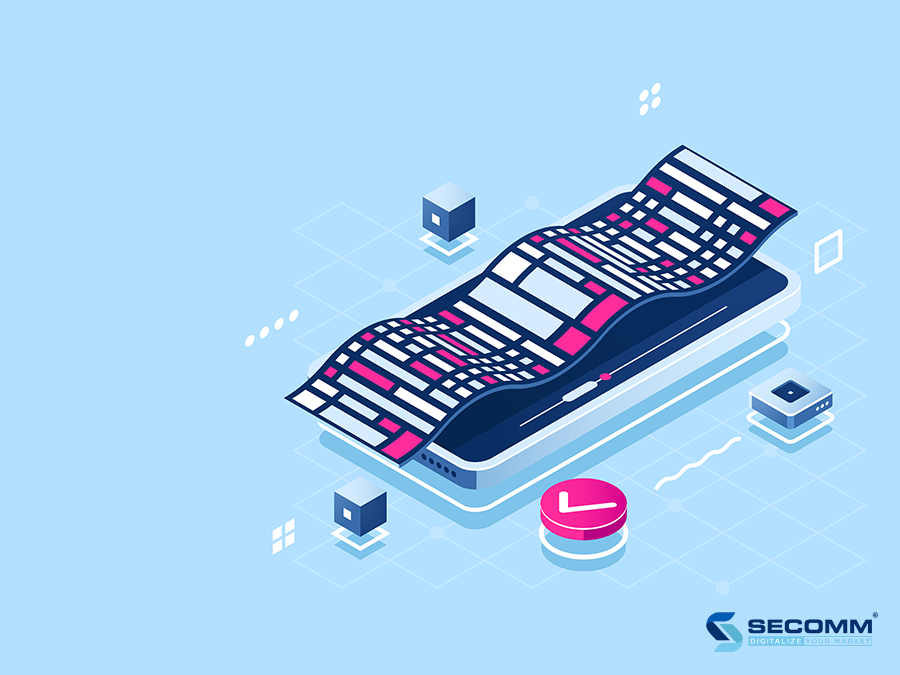
Product-centric is still an essential factor in most campaigns. However, customer-centric will be the necessary combination to enhance user experience, which making brands transform. Products exist in the world with the ultimate goal of meeting customer needs. Therefore, identifying customer needs is a crucial starting point for a digital transformation campaign.

That is how the Maggi brand cleverly introduces cuisine recipes combining with soy-sauce on their website. This action increases convenience for cooking lovers. Customers feel more excited when their everyday-cooking gets more of the brand-attention though buying only one soy-sauce bottle.
In general, customer-centric is a long-term transformation requiring businesses to have a proper awareness of their target customers. This awareness should also form in every staff of the company to make brands transform. Besides, this customer-in-center philosophy acts as a value connecting businesses with their customers; but not a task to be completed and to get rid of.
The digital age witnessed rapid and unpredictable changes requiring businesses to have timely adaptive solutions. Products are not only produced for quality but for customer convenience. Other customer needs are also considerable except for products themselves, namely membership programs, accompanying promotional gifts. Customers also tend to shop more on ecommerce websites, which leads to a requirement to manage information, data, and technology platforms. Epidemics also become dangerous, increasing unforeseen risks for businesses.

Utilizing the challenges will be sure leverage when brands transform into the digital age. Besides, people are still the critical factor, no matter how advanced technology is. Therefore, businesses first need to focus on the internal structure: human resources, processes, products, and customer services to complete the transformation.
The COVID-19 crisis has globally worsened since the Government issued a social-distancing-order as the number of confirmed coronavirus cases continues to increase. However, recently, the ecommerce industry has had a speedy growth, as people now prefer to shop online while staying home. This time is much higher challenging for every business in Vietnam and an opportunity to make brands transform themselves.
At SECOMM, we will accompany clients on every ecommerce step to ensure comprehensive solution-providing for their ecommerce transformation. The brands transform successfully in a digital age when they are operated with a sustainable website platform. We will be the starting point for this revolution. Contact Us for more detail.
 2
2
 5,164
5,164
 22
22
 1
1
The variety of products published on every ecommerce website is always diversity-guaranteed to meet almost the market needs. However, ensuring the criteria of goods quality has been an unresolved question up to now, becoming one of the barriers to the ecommerce industry. The burning issues of low-quality products, counterfeit consumer goods are eventually uncontrollable and exist in the market. Those effects can be derived from a couple of factors that can be analyzed from the perspective of the sellers, ecommerce enterprises, and consumers.

The low-quality of goods has come from the traditional trading model operated offline, and merchants inevitably take responsibility in that case. Although consumers can contemplate the offline model seriously, the product quality is still sellers’ responsibility and control. Uncontrollable-quality sources become a critical issue when merchants provide goods with a profitable price to get much higher returns by selling fake or inferior quality products with very attractively “low” prices. In the flourishing process of online business, those unsolved issues have the chance to spread across the online-offline frontier and lose control.
When the quality issue emerges, e-firms are the first to be impacted. Those types, namely B2C and C2C, act as middlemen for merchant support to sell products on ecommerce exchanges.
Consequently, those enterprises restrict the source of inferior products and entirely rely on consumer feedback to address the issue in a very passive way. The quality barrier prevents enterprises from gaining consumer trust to maintain their loyalty.
The spread of low-quality goods partly comes from consumer awareness. In the e-market, there is still a consumer group preferring inexpensive or on-sales items to other high-price and authentic products to save the living cost or try a variety of products. They tend to choose low-price items neglecting the origin and information while never complaining about the lack of product-clarification. Low-awareness behavior gradually contributes to the growth of uncontrollable-inferior products and as a result, the development of barriers to the ecommerce industry.
The growth of poor quality products depends on many factors and the responsibility of sellers, businesses, and consumers for the sake of a healthy and trustworthy market.
The need to change buying behavior from offline to online is also one of the barriers to the ecommerce industry in Vietnam. To certainly clarify, take a look at three fundamental behavior-levels happenings when consumers make a purchase.

The first group is pure traditional shoppers, who tend to see and touch what to buy. They wholeheartedly believe their eye-process can ensure more quality and conformity of the product. Therefore, they never trust any online items because of unmanageable-value. As a consequence, changing the buying habit of this group is the most challenging requirement.
The second group is hybrid buyers combining traditional and modern buying styles. That hybrid group tends to select-for-best. For instance, they can quickly add a book or ten pens to their cart because it is more convenient than buying at the bookstore. However, they will directly go to a clothing store to choose an item that fits their size and ensure the fabric quality. That behavior similarly happens when they buy shoes, bags, or other fashion items. In brief, hybrid customers have changed their buying habits in the most popular fields over the years. Hence, there will be much higher requirements for unique products such as fashion items, technology devices, motorcycles, and cars in some cases.
The last group tends to complete online shopping. They take advantage of online shopping as a convenient and speedy tool, helping them save more time during the shopping process. However, this group still has some challenges: maintaining trust-worthy and credibility to upgrade target consumers to loyal customers.
While the increasing mobile-usage has somewhat raised the online shopping demand, the user-habit transformation is a worth-factor that needs better solutions in long-term strategies or it will be one of the barriers to the ecommerce industry. In particular, the significant element affecting ecommerce user-habit is the story of quality-expectation and the reliability of online stores.
Long-term productive resources in the ecommerce market are also one of the considerable barriers to the ecommerce industry. For this purpose, the ongoing need includes warehouse management, branding & marketing, payment & shipping processes. Consequently, all of the elements should require enterprises to keep the non-stop funding on continuous losses.
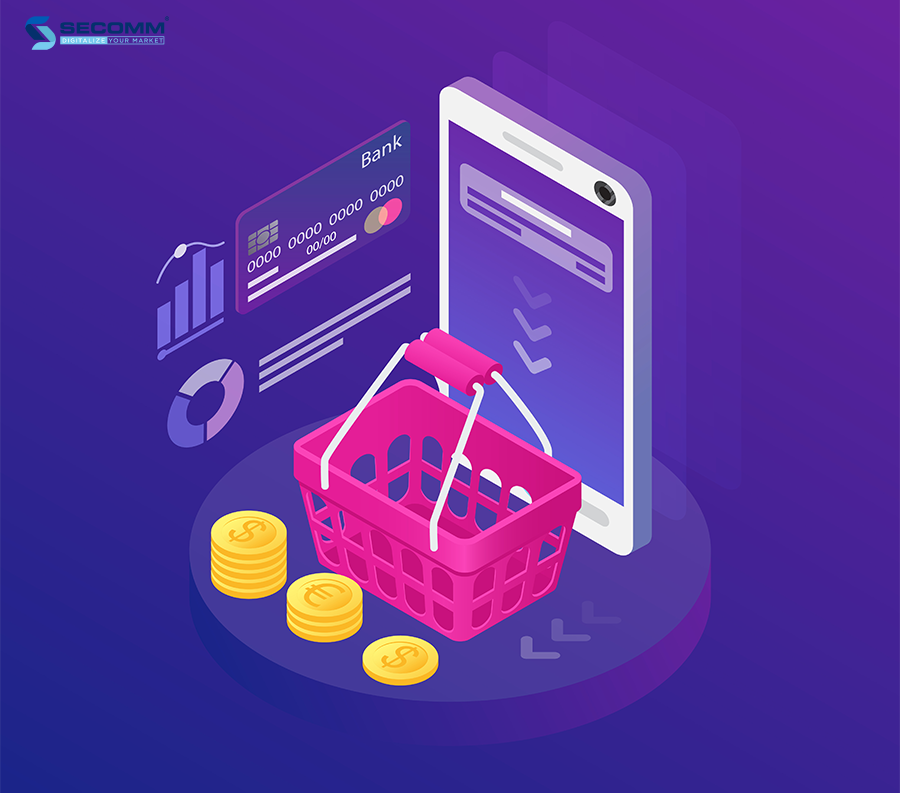
Along the same lines, small and medium-sized enterprises can not afford long-term competition versus the ecommerce giants in the market. For instance, international names like Alibaba, JD.com, or Amazon create an enormous distance for other SMEs to overtake.
In general, the capital investment race invisibly makes large ecommerce businesses more robust and extensive. Meanwhile, it oppositely generates more barriers to the ecommerce industry in Vietnam due to the lack of sufficient capital in the long term. Following this, depending on each organization, there will be many issues when operating an e-business. Therefore, it is necessary to have the most comprehensive outline and meticulous ecommerce study to set the oriented developing goals.
 2
2
 8,728
8,728
 0
0
 1
1
To discuss the establishment of ecommerce businesses in Vietnam, firstly, it is necessary to look at the development of the website systems. Years ago, the websites primarily displayed information on the Internet for easy access from audiences. Gradually, it has become a competent tool in creating brand identity, improving reliability, and supporting businesses to collect one-click testimonials from their visitors.

Over time, businesses want to increase productivity by selling products while saving costs and facilities. On the other hand, customers also need to buy products faster without directly going to the store. That is the reason leading to the birth of ecommerce.Today, the flash development of ecommerce allows businesses to easily access the market while increasing the opportunity to maximize user experience. In Vietnam, the ecommerce market has only been growing in recent years but has made a breakthrough with prominent brands like Shopee, Tiki, and Lazada.
Magento has excellent functions, which highly create flexibility and adaptability, accommodating all sizes of ecommerce businesses in Vietnam. However, Magento is not very friendly for beginners. Instead, the platform has a massive range of features that are adaptive for almost the user-community.
WooCommerce is not an autonomous platform to build an ecommerce website. It is a type of plugin running on WordPress. In other words, WooCommerce will optimize ecommerce functions for the website community based on the WordPress foundation. Thus, enterprises can start an online development plan in a more accessible and faster way.Utterly different from Magento, WooCommerce is more comfortable to use, especially suitable for beginners. Plus, it also possesses enough extensions handling almost basic tasks from product management to payment methods that can bring a website to the top ecommerce business in Vietnam.
Pick up enormous scores from users; Shopify possesses the functions to integrate SEO, supporting the website system work, and customize fluidly. It also provides services based on the SaaS model with the main control center.
Haravan is an open platform allowing easy website creation with similar characteristics to Shopify and WordPress. The platform possesses various features providing more conveniently supportive sales-management tools, especially the multi-channel sale on ecommerce websites, namely Lazada, Shopee, and Tiki.
The website system is a prerequisite to be maintained, updated regularly and continuously because it is the only interface connecting businesses and customers. For ecommerce businesses in Vietnam, designing a web system plays a crucial role in contributing to the success of an online business or its failure. This design phase is usually performed by the UI/UX team responsible for both visual and user experiences on the websites.

With the experience of developing ecommerce websites, SECOMM developers can apply most of the current platforms to meet our partners’ needs, especially ecommerce businesses in Vietnam. We always value the quality of our work and provide the most appropriate solutions to the occurring issues. Promptness, timeliness, and quality are the consistent goals that we always aim at in the process of operation.
 2
2
 4,212
4,212
 0
0
 1
1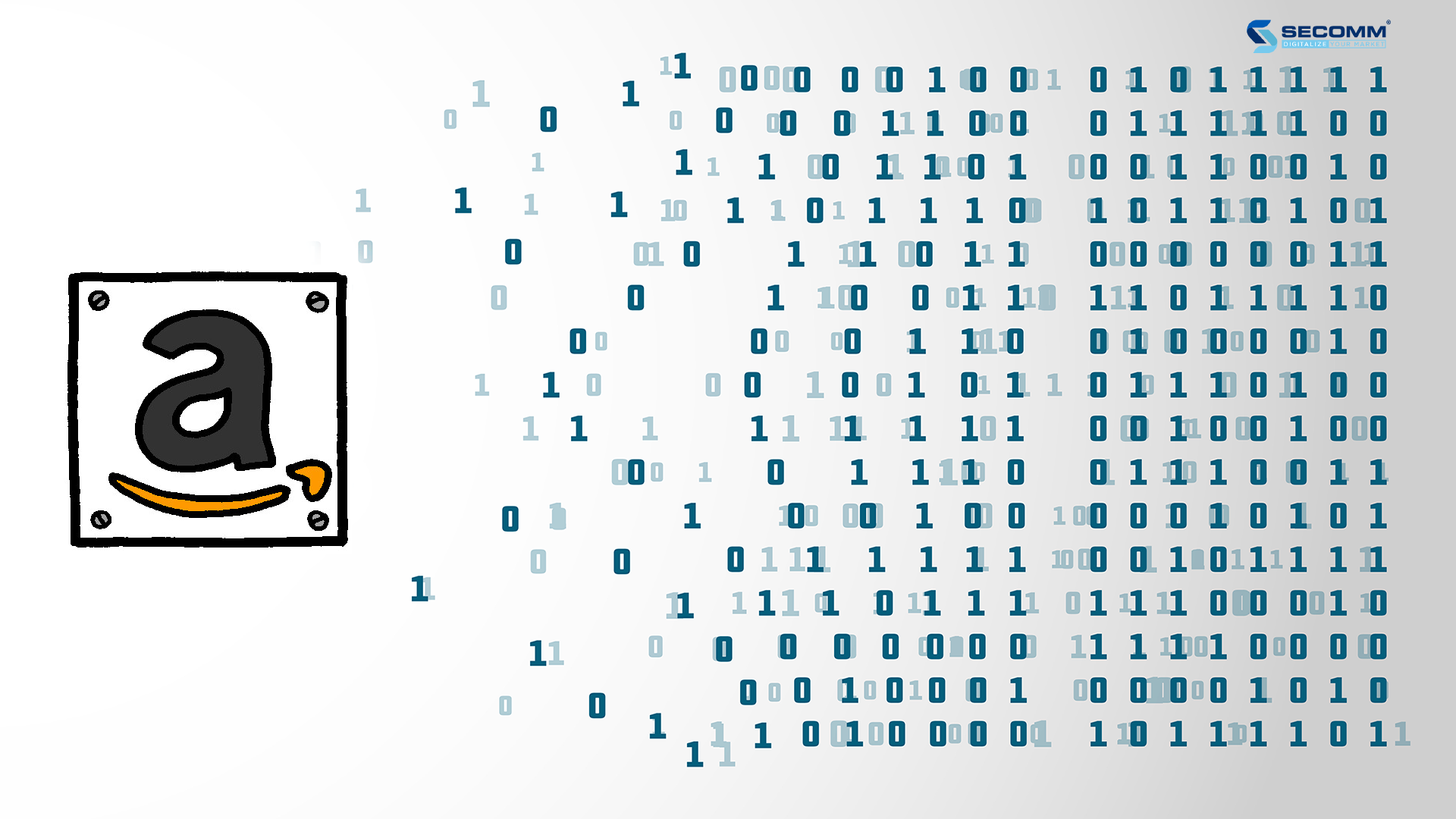
One of the factors stimulating e-business growth is the high demand for the internet, in which Vietnam is the top-country in terms of internet users. Therefore, online selling has a fast-growing rate with impressive recorded statistics and contributes to the country’s market economy in many ways. The following is the large-scale blooming of e-business in Vietnam.
Besides, online businesses can easily access the market while just using about 1/10 of the marketing channels’ cost. Low advertising costs have increased the popularity of online sales, which grows not only on the domestic scale but also globally.

Since 2016, e-businesses in Vietnam have undergone significant breakthroughs by cooperating with international partners, making businesses participate in the e-business market, and marking the premise for the outstanding growth of e-businesses at present.
The Amazon penetration into the Vietnam market has come up with new opportunities for a huge community of e-business in Vietnam. The country has a strong potential for traditional handicrafts, which are considered unique and ideal for selling online. With that strength, Vietnam will promote domestic products to international markets at competitive prices.
Under the support of Amazon Global Selling, Vietnam brands can integrate with international e-markets with significant growth, which is a step toward the digital economy in Vietnam.
Vietnam has expertise in producing goods, so Amazon Global Selling’s participation meaningfully contributes to accelerating the market-expanding process for both international partners and consumers. That contribution can boost the working process for Vietnamese businesses and the ecommerce market share of the economy.
Besides wide-open opportunities, e-business in Vietnam quite faces significant challenges from the Amazon advent. Firstly, Amazon makes domestic ecommerce in the face of fierce competition. The Vietnam market had welcomed Alibaba previously.
Nevertheless, it was not overly ambitious because large enterprises had their proven capability in this field, namely Shopee, Tiki, Sendo. However, the long-term race invisibly extends a boundary for SMEs to cross over or get close to the same level.

Secondly, publishing products in the international ecommerce field increases expenses. The more giants join the ecommerce game, the more earnestly and competitively the race of spending money becomes. However, plenty of e-businesses focus on the spending process of selling 1 billion dollars of goods without having correct forecasts on long-term expenses. In the long run, over-spending will require more investment, affecting the bottom-line growth, namely the businesses’ net profits.
On the other hand, the origin and quality of goods need to be guaranteed. Regarding the current ecommerce market in Vietnam, fake or counterfeit products have not been solved thoroughly up to now. As a result, selling on Amazon will face restrictions if businesses can not control their goods’ quality. Simultaneously, it requires policies from the government to promote ethical businesses within the Vietnamese economy.
In general, Amazon has created a new breeze for e-business in Vietnam. It plays a vital role in stimulating market competitiveness, improving product quality, and user experience for great customer-oriented support. However, to do that, businesses need to have the right strategies in addressing challenges and difficulties to shorten the cooperation process with both partners and international customers.
 2
2
 6,443
6,443
 0
0
 2
2
Several conflicting opinions often appear, which leads to much suspicion about the actual benefits that content brings to businesses. The doubts possibly stem from different issues when implementing client research or positioning the development orientation. A B2B effective online content strategy results from a meticulous and thorough investigation of all aspects of the business, including the market, competitors, clients, entrepreneurial potential, and much more.

Those factors are the initial steps for the content strategy. When the letters’ sequence creates their miracles, businesses smoothly fulfilled the original objectives to reach out to the developing goals. As a result, content shapes everything that the industry puts out, prompting customers to take action with the services or products they desire.
In other words, SEO will have no result if supportive content does not exist. With a diverse and high-end content system built in advance, SEO specialists can easily optimize the website rankings and reliability on search engines with more strategic approaches. Besides, businesses can use BLOG to develop an abundant content base, attracting more users to visit the website.
Business needs to research accurately and specifically about the target audience to implement an effective online content strategy. Content creators also need to determine who they are writing for, what they are writing for, and what value are they seeking?

First, find out information about businesses to identify audience target with the following fundamental questions:
The buying process
Sales goals are also an important step to prepare for an effective online content strategy. These include business goals and content goals. In particular, business goals play as the direction for specific objectives and targets in businesses, including criteria on sales, market share, growth, revenue, and profit. Besides, the content target is a part of the marketing objective, a supporting factor for the business goals in developing the speed of goods/services distribution, brand positioning, value in use of the products, and loyal client creation base for the brand.
Specific content targets will create a solid foundation for a content strategy from the simplest and most basic targets. The following proposed targets will be:
It is acutely worth reminding that simultaneously achieving all the goals is impossible. That is a greedy view. Instead, prioritizing the most important ones in the short/long term and dividing the targets according to each stage of business growth.
In the next step, concretize the above primary goals with specific factors based on the S.M.A.R.T principle. This process will help to set more oriented goals.
S refers to “specific”. The primary goals mentioned above need to be more specific. To specify them, ask some of the questions by using the “6W” formula, namely:
Who?
What?
When?
Where?
Why?
M is “measurable”, which means the goals in detail. Those quantitative factors can be data collection, revenue, sales performance, customer satisfaction, and customer experience surveys.
A means “applicable”. No matter how specific the goals are, they need to be feasible and appropriate to the team-ability. Sometimes, to accomplish these goals, the staff need to improve their skills or undergo training processes. These are all essentials to approach closely to the previously measured goals. From that basis, marketers can estimate a suitable figure for the target. For example, if the sales revenue increases by 5% last month, setting a goal to increase sales performance by 10% this month. Oppositely, setting the 30% increase target would be unreasonable. Although there will be differences and characteristics of every single industry, measurable goals require a meticulous research process in general.
R is the beginning of “realistic” or “relevant”. To set the goal of studying abroad in Australia, make sub-objectives such as studying IELTS, finding a study abroad counseling center, applying for a VISA. However, studying Korean is not related to the whole abroad goals; it can not join the study plan. That plan is an underlying visual instance for a better understanding of relevant and real goals.
T, talks about time. The limit of time is essential to proceed with the on-time plans and break down the goals into actionable tasks. Time-bound brings a consistent and effective online content strategy in all aspects.
Unique and innovative ideas impressively contribute to an effective online content strategy. However, they are all a plus, not compulsory. In other words, creative ideas are supportive tools that help businesses grow faster, but more than a creative-content factor needed to accompany enterprises with long-term development. To do so is to gain the foundation of Marketing understanding that distributes creative content into suitable channels.

Generally, novelty can attract potential target audiences. Here are some of the suggestions to be more creative when brainstorming ideas to run an effective online content strategy:
B2B enterprises do not just need only one effective online content strategy. However, the effective one produces a substantial range of benefits for business, from improving the website-popularity to increasing sales revenue.
SECOMM, with expertise understanding, always seeks prudent solutions in both web structure and content system for partners in the working process. With well-trained staff, we understand how an effective online content strategy impacts brands. We hope to convey new values from old platforms and build fresh ideas from the hybrid of information based on materials.
 2
2
 4,087
4,087
 21
21
 1
1
The first workshop of TECH TALK 2020, in other words, had a great sharing time making the team connect closely. Thus, Secommers not only have time together but also got new Magento knowledge. Thanks to the framework of Ms. Ivy, the team had the opportunity to share those foundation topics:

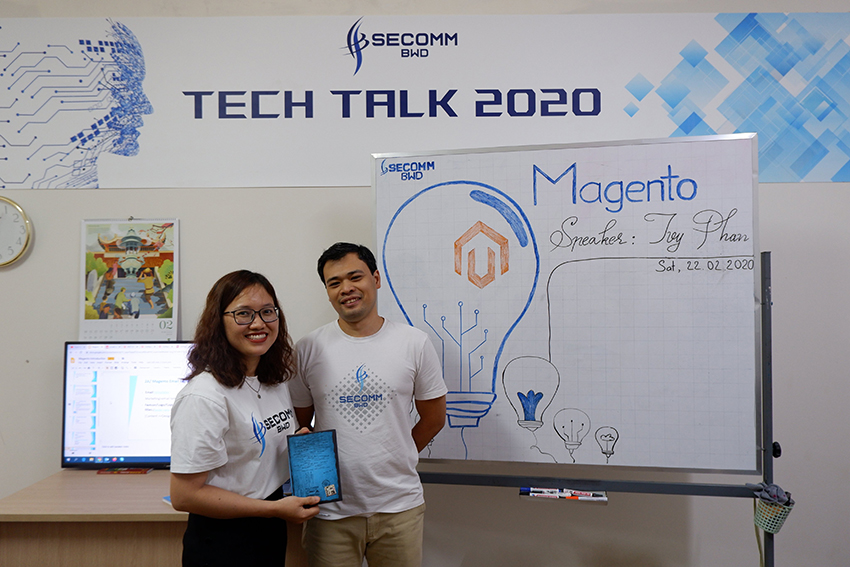
 2
2
 3,131
3,131
 10
10
 1
1Subscribe to get the latest eBook!
Hotline